ALTERNATIVE BEACHES NEAR LISBON (AND WHERE TO EAT AND DRINK NEARBY)
One of the particularities of Lisbon that attracts lots of travelers every year is its proximity to the ocean. Of course it helps that the weather is quite moderate all year long and, while you may not go out for a swim in the Atlantic in November, it’s remarkable how many days of sun a year we get to enjoy around here. But does Lisbon have a beach? Even though the Portuguese capital has a waterfront, it is that of a river, the Tagus. But the possibility of spending a day at the beach lies very nearby, as there are many beaches in close proximity to the city.

Seafood dish are Ericeira village
Whether you travel towards Estoril and Cascais, or cross to the south bank towards Costa da Caparica or Setúbal and the Arrábida Natural Park, there are lots of beach options for all kinds of preferences. Some are within easy reach from Lisbon, using the public transportation network, namely the train towards Cascais. To visit others you may need to hop on a seasonal bus or, if you plan on getting further away from the crowds, having your own car can prove useful. Some of the beaches near Lisbon have facilities such as restrooms, showers and beach bars, while others feel a little more remote, wild and unspoiled (that includes the beaches in literal natural protected areas, such as Arrábida and Sintra-Cascais). There are areas perfect for families with kids, others where you can take your dog to, areas for the LGBT community to mingle, and even spots where nudists can let it all out.
With so many great beaches around Lisbon, how can you select one that tickles your fancy? Think about your means of transportation, the kind of landscapes you are most into, if having proper facilities nearby matters to you, and such.
Famous beaches close to Lisbon include Carcavelos, Caxias (which is actually the nearest beach to Lisbon), the main areas of Costa da Caparica and even the beachfront areas closer to downtown Cascais. Today, we’d like to focus on beach areas which are less touristy, feel more intact from a natural perspective and, huge bonus for us, have good food and drink options nearby – it’s almost like we’re drawing our very own Lisbon beach map here.
Ready to spend a day at the beach Oh! My Cod style? No need to pack your lunch… as we have delicious recommendations for you, following what us locals tend to love eating when going to the beach.
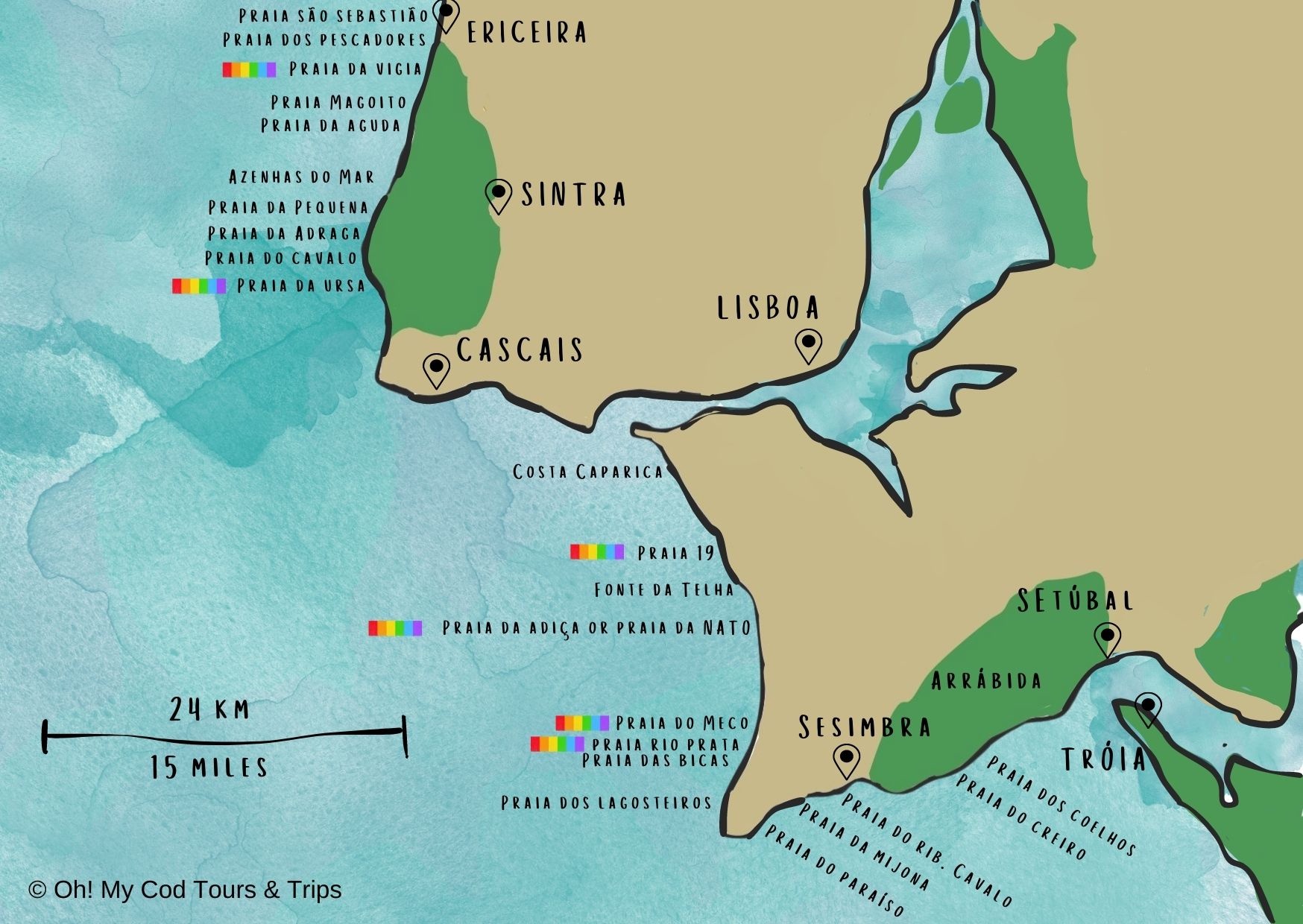
Arrábida beaches
How to get to the beaches within Arrábida Natural Park
While driving your own car could come in handy to get to Arrábida’s protected area, it is certainly not necessary when you make Lisbon the base of your trip. The several beaches within Arrábida can be fairly easily accessed from Setúbal, so the main thing for you would be to get from downtown Lisbon to Setúbal’s city center. This can either be done by train or by bus. The train to Setúbal departs from both the stations of Roma-Areeiro (part of the green line of the metro), Sete Rios (Jardim Zoológico stop on the blue line of the metro), or Campolide (no metro here, but well connected with Carris bus network). The train operated by Fertagus (timings here) takes a little under one hour to get to Setúbal.
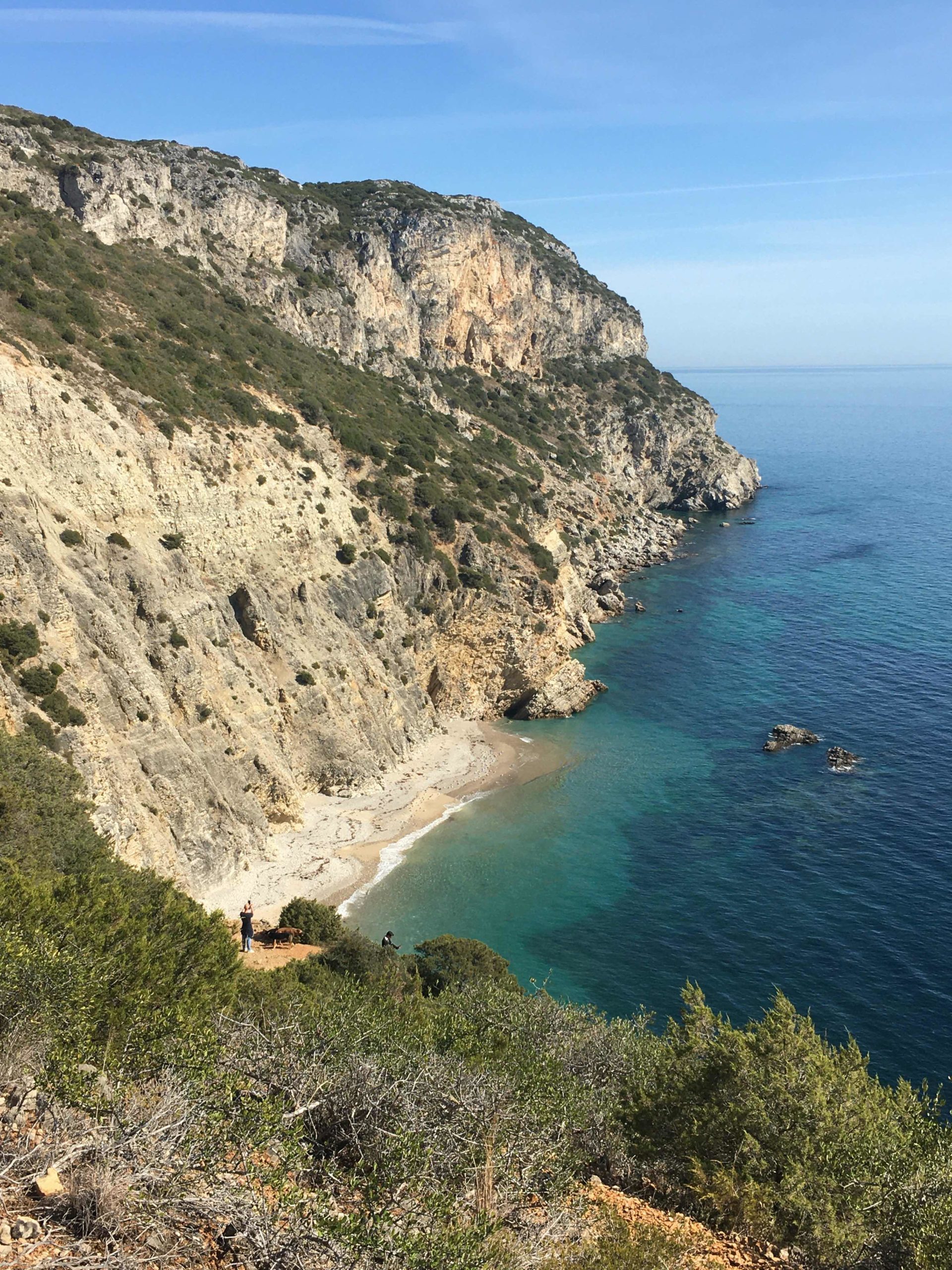
A trekking we did to Hell Beach. You can guess why such a name right? If you are not in a trekking mood there are plenty of other options.
To get to Setúbal by bus, you can either hop on bus 561 by company TST, departing from Sete Rios, or do so from the other end of town, in Parque das Nações, taking advantage of bus 562, by the same company. While from Sete Rios buses run every 60 to 90 minutes, from Parque das Nações they do so more frequently, between 30 to 60 minutes.
Once in Setúbal, you can reach your beach of choice by bus, but the line would depend on which beach you prefer. While renting a car may seem tempting to do some beach hoping (as it is certainly worth it to hit more than one beach in the area!) you must keep in mind that during the high season in the summer, as this is a natural protected zone, driving in the area is heavily restricted, so you’d be better off taking advantage of the local buses. You can find more information about the car-free Arrábida initiative, including the timings of the beach shuttles, here.
What are the beaches in Arrábida Natural Park like?
The beaches within Serra de Arrábida don’t get this much praise out of thin air. The fact that these beach areas are within a protected area ensure that they stay as intact as it’s possible this close to urban centers. They aren’t exactly virgin beaches, but you’d be hard pressed to find beaches as spotless as these within such close proximity to Lisbon.
Arrábida’s beaches are known for their powdery white sands and tranquil crystal-clear waters – so much so that the opportunities for snorkeling and diving are stupendous around here! Nature lovers are bound to have a good time in Arrábida, not just by the beach, but by exploring the natural park that serves as a stunning backdrop on the oceanfront areas. Arrábida Natural Park hiking trails are some of the best forest trails near Lisbon and, even when it gets too hot to trek, your efforts can be rewarded with a refreshing dip in the ocean after all those kilometers.
The steep hills invite for some time connecting with the natural surroundings. No wonder between the years of 1542 and 1834, Arrábida was home to a convent of Franciscan monks. You can still visit this 16th century convent, officially known as the Convent of Our Lady of Arrábida (Rua São Lourenço, São Lourenço), for a religious-meets-fairytale experience!
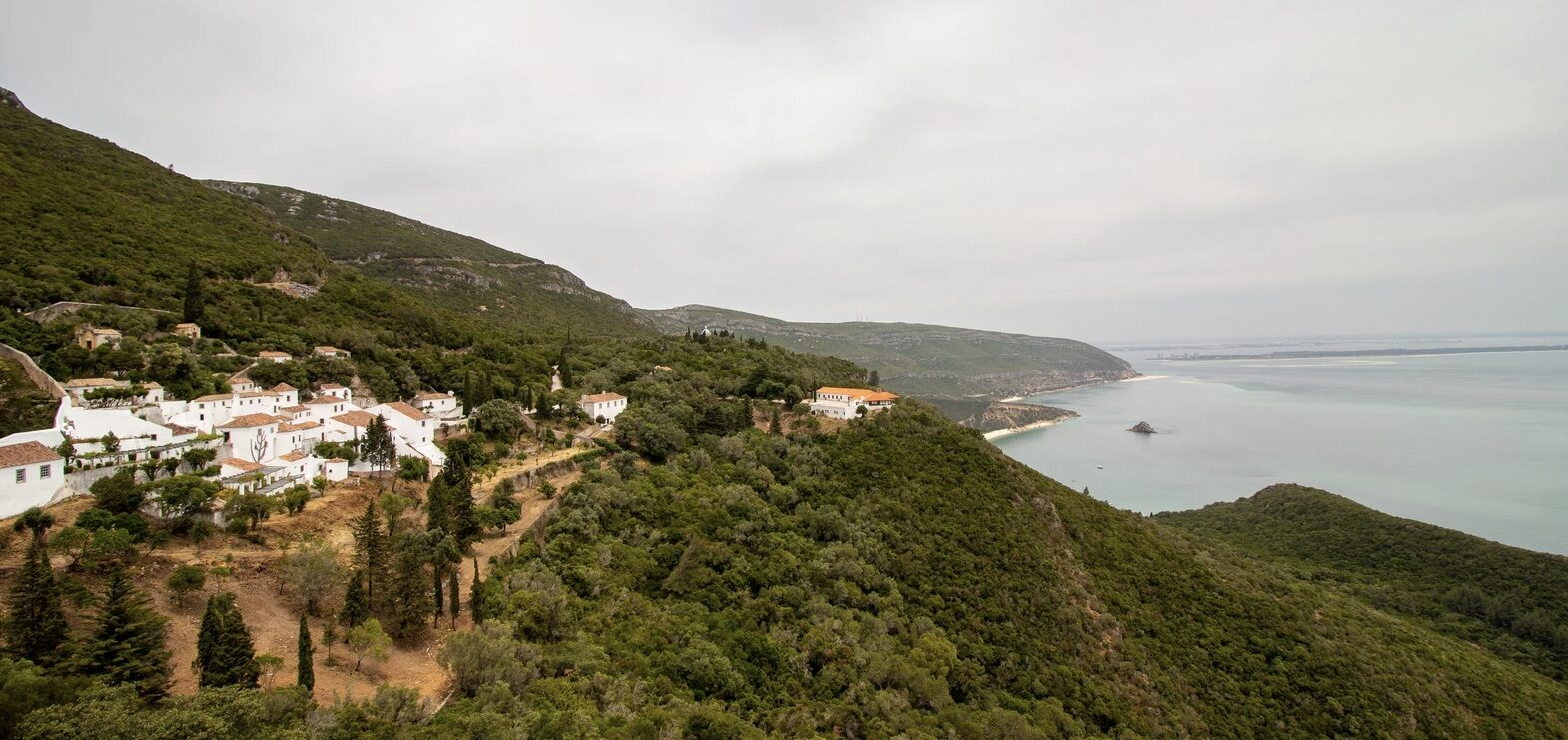
Arrabida convent and bay
Best beaches in Arrábida Natural Park
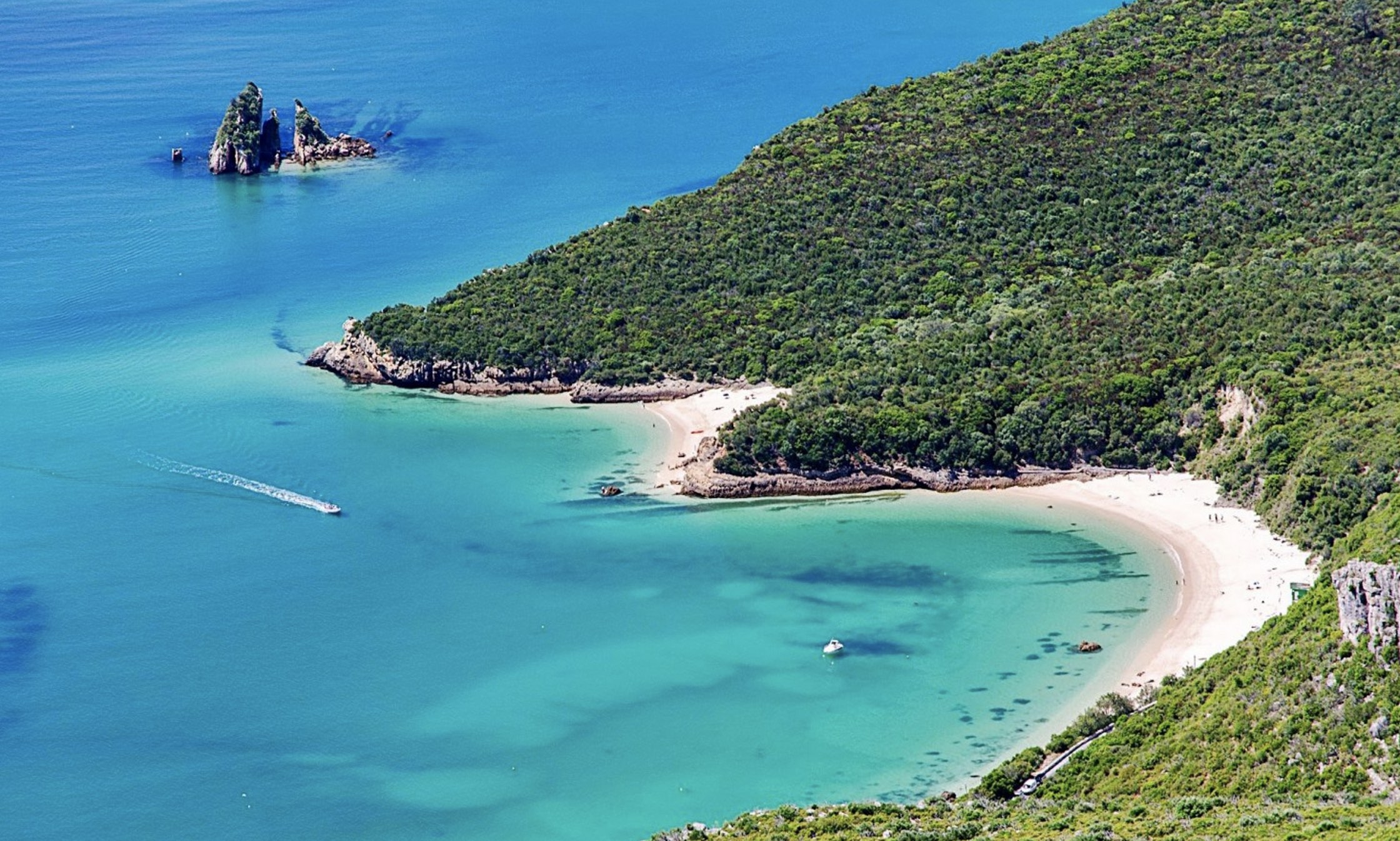
Galapinhos beach
Portinho da Arrábida, Galapinhos beach and Praia da Figueirinha (the longest stretch of beach between Setúbal and Sesimbra) are, quite probably, the most popular beaches within this side of Arrábida. But as we are focusing on lesser known beaches, with a certain alternative vibe, we will be talking about some of our preferred options in the area, which involve striking scenery, lesser people around and great food options nearby!
Praia do Creiro is one of our favorite beaches in Arrábida and, for us, it’s actually one of the best beaches near Lisbon. It’s almost hard to imagine how an area with such a secluded feel, bathed by translucent emerald waters, is just so close to us! Describing Praia do Creiro could almost sound like we’re describing a beach in the Caribbean, minus the palm trees (ok, and to be completely fair, disregarding the water temperature too). This is a mostly deserted beach and one of those very rare places in the word where you almost feel like the surroundings are there just for you, while you blend in and, even if for just a little while, sort of feel like one with the environment.
Another thing we quite like about Creiro beach is that, right between the parking lot and the beach itself, you can see archaeological ruins dating back from the times of the Roman Empire, that is, from about 2000 years ago. These ruins include tanks which were used to salt fish and make garum, a fermented fish sauce which we have an entire gastronomic experience dedicated to, as it is closely related to the cultural identity and food heritage of Portugal and southern Europe from back in the day.
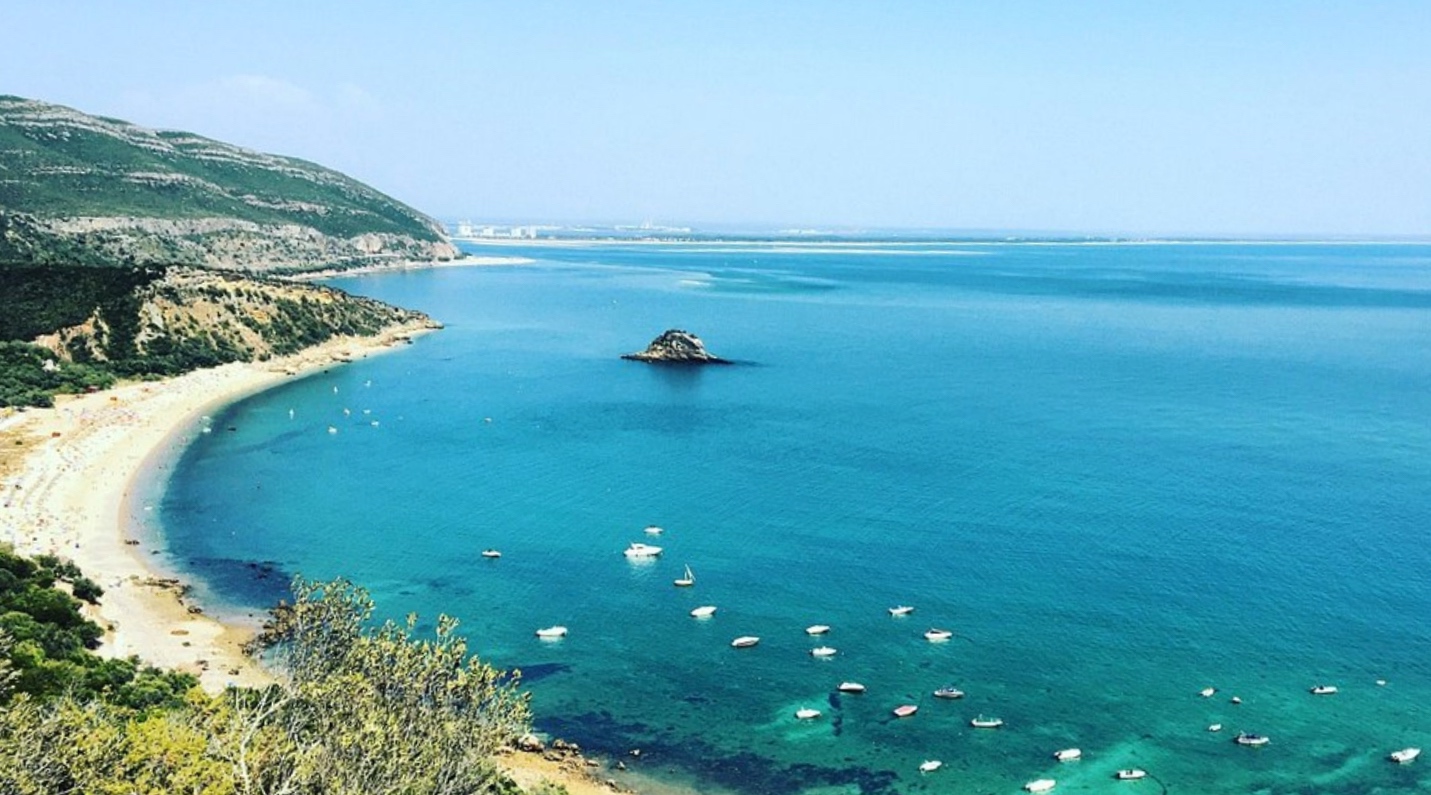
Creiro Beach
From Praia do Creiro, you can actually swim to the next beach, Praia dos Coelhos. Of course you could also get there by walking up the road, but how often could you actually say that you went beach-hopping by swimming? Don’t be too intimidated by the sound of our suggestion here, as not only is the journey really short, the waters tend to be rather calm too. Coelho is a cove like beach, with pristine sands. If you are traveling by yourself and plan on swimming here, we’d recommend getting a waterproof bag where you can keep your belongings safe and, generally speaking, pack as light as possible, as there’s almost always going to be some walking around where you plan on exploring the area properly. As it gets really hot during the summer and dehydration can be a real threat when you are at some of these more remote beaches (even though you’ll be just about 10 kilometers, or 6 miles, from the city of Setúbal), it’d be a good idea to always keep a bottle of water with you.
Praia do Porto da Baleeira, also known as Praia do Paraíso (that’s Portuguese for “paradise beach”), is a wild beach just past Cabo Espichel, an iconic cape on the western coast of Sesimbra. It’s a small rocky area and, when the tide is high, the sandy area actually gets eaten by the Atlantic ocean. To get here a car would actually be useful (unless walking is really your thing!), but you ought to drive down a dirt town. The path is really not obvious and you’d be better off following the GPS coordinates: N 38° 24.930 W 009° 11.366. If you are into snorkeling, you’d be hard pressed to find a better spot for it around here. Pack your snorkel or sign up with a local operator running snorkeling classes for beginners and adventure trips at Baleeira beach.
Even though Praia da Figueirinha, which we briefly mentioned above, is certainly amongst the most popular beaches in Arrábida (that explains that you can even rent watersports equipment or a lounger and sun umbrellas), that certainly doesn’t mean it’s not breathtaking. And precisely because it is popular, it has good options for dining nearby, some of which we explore right below…
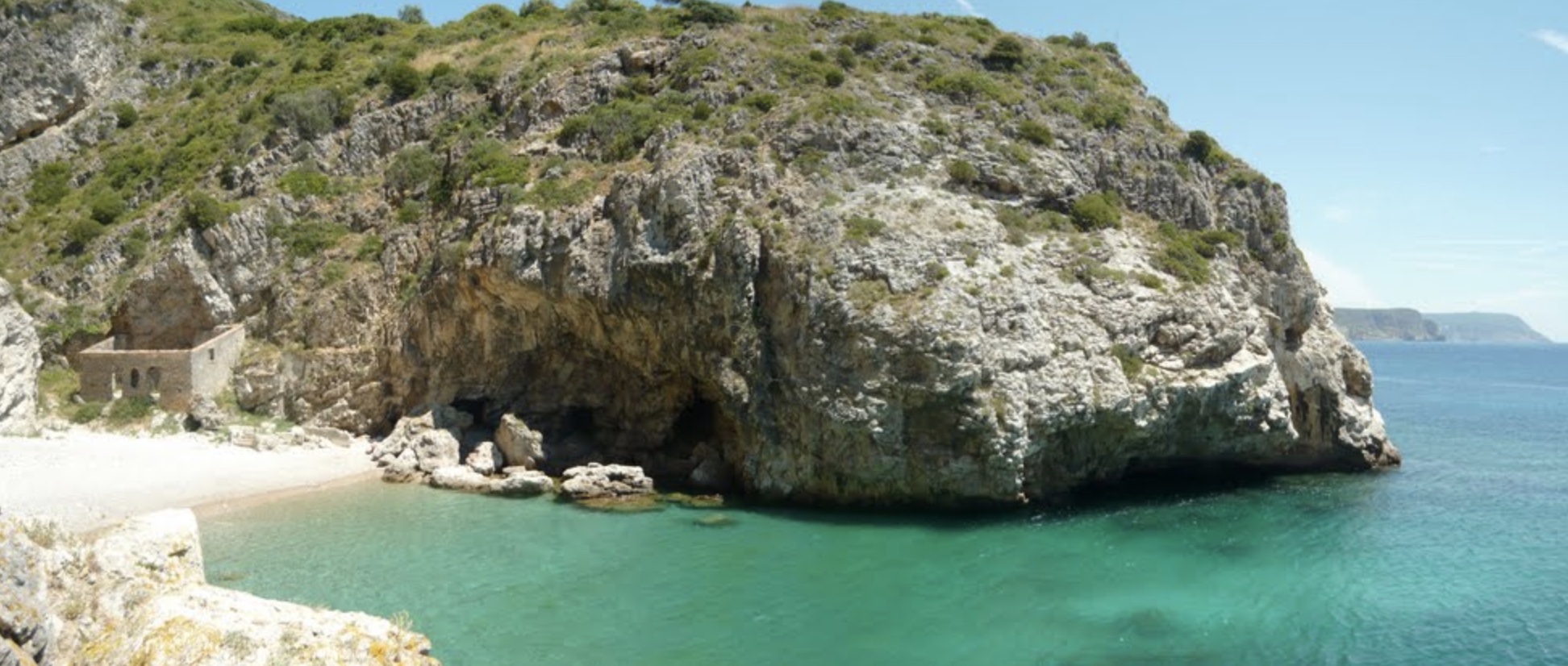
Baleeira beach or Paradise beach
Where to eat and drink when you go to the beach in Arrábida
When Portuguese people head out to the beach, there’s a certain set of standard foods we like to eat. As you can easily imagine, fresh fish and seafood top that list, either in the form of simple gills, more elaborate recipes, or petiscos, that is, small plates perfect for snacking on or sharing.
We don’t always eat by the beach when going to Arrábida, as there are tons of good restaurants in Setúbal and Sesimbra, where you can probably eat better for less. But then there are those days when you want to grab a bite to eat, and then continue sun bathing, and that’s what restaurants by the beach are exactly for!
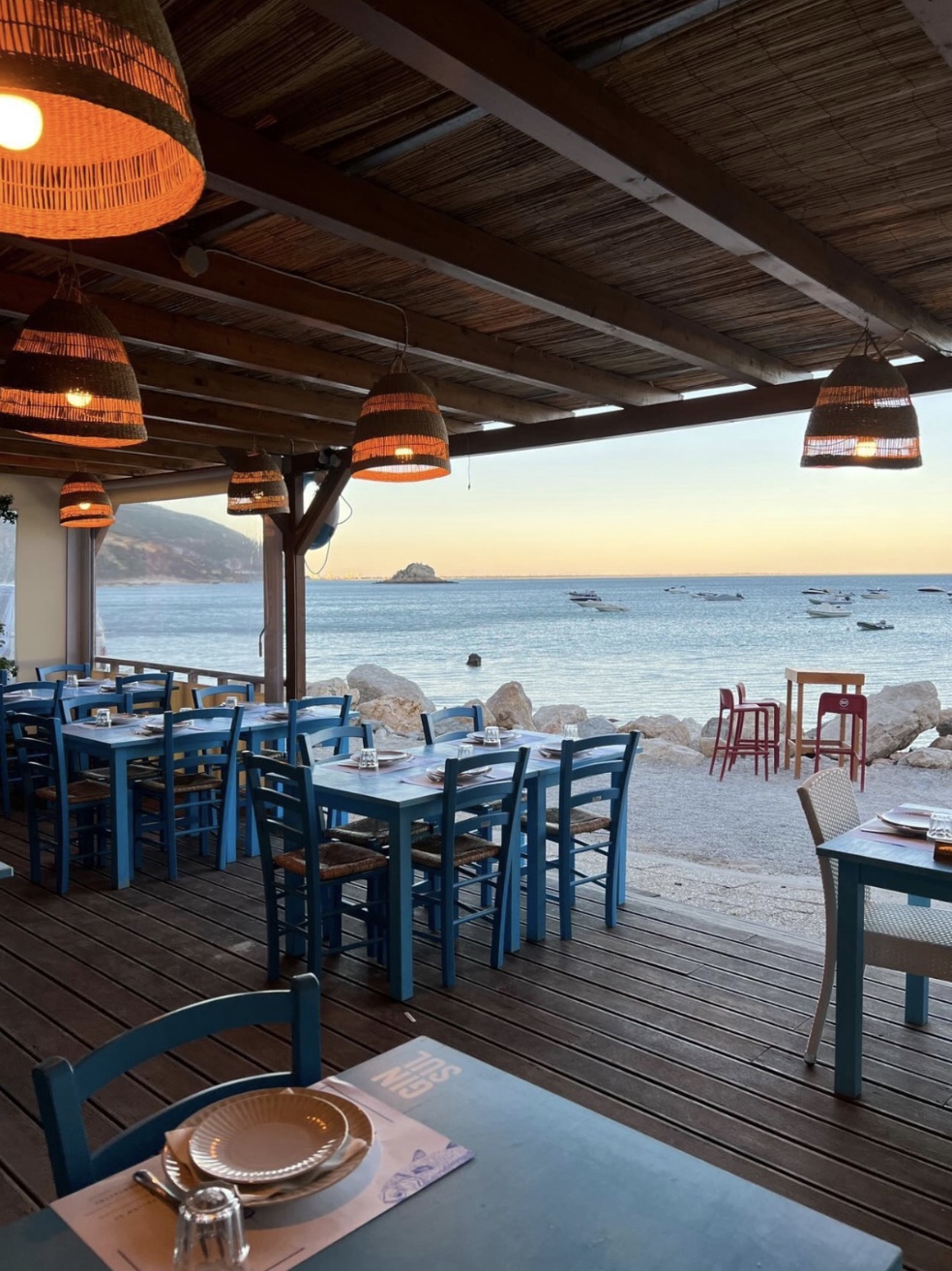
Farol restaurant
At Praia da Figueirinha you will find Bar Mar and Figueirinha Beach Lounge, a restaurant and bar with a lovely outdoor terrace overlooking the beach. Their menu is all about the simplicity you’ll often come across in this kind of establishments by the beach all over Portugal, relying on the freshness of the catch of the day, enhanced by simply grilling it over charcoal. For a more festive meal, we recommend trying their caldeirada, a typical fisherman stew with several varieties of species simmered with potatoes in a tomato rich broth, or their saucy rice dishes such as arroz de marisco (seafood rice) or arroz de tamboril (monkfish rice). If a big meal is not what you’re in the mood for while at the beach, opt for a snack such as choco frito, a typical preparation of breaded and deep fried cuttlefish strips, which will go down perfectly with a cold bottle of Portuguese white wine or beer.
You will not come across commercial establishments alongside some of the more unspoiled beaches we like the most and which we speak of above. So, if you want to sit down for lunch, you’d have to consider one of the most popular spots in the area, such as Portinho da Arrábida. The first good news is that Portinho da Arrábida is very close to Creiro, and the second good news is that this is actually a fishing village, so good fresh fish is a given around here!
Some of the best restaurants in Portinho da Arrabida include D’u Portinho (Rua do Portinho da Arrábida), where chef Ricardo and his team sure show they know how to handle fish and seafood. Farol (Rua do Portinho da Arrábida) is algo a good option for lunch, dinner, or a drink with views towards the ocean. These aren’t exactly fancy restaurants, but because of their privileged location, they aren’t the most affordable options either. For something more casual, head to Bar Mafalda (Rua Serra Mãe 26), where the ambience is as cool as the beer, which goes down nicely with their quick food options such as typical snacks and grilled sandwiches.
Sesimbra beaches
How to get to Sesimbra’s beaches
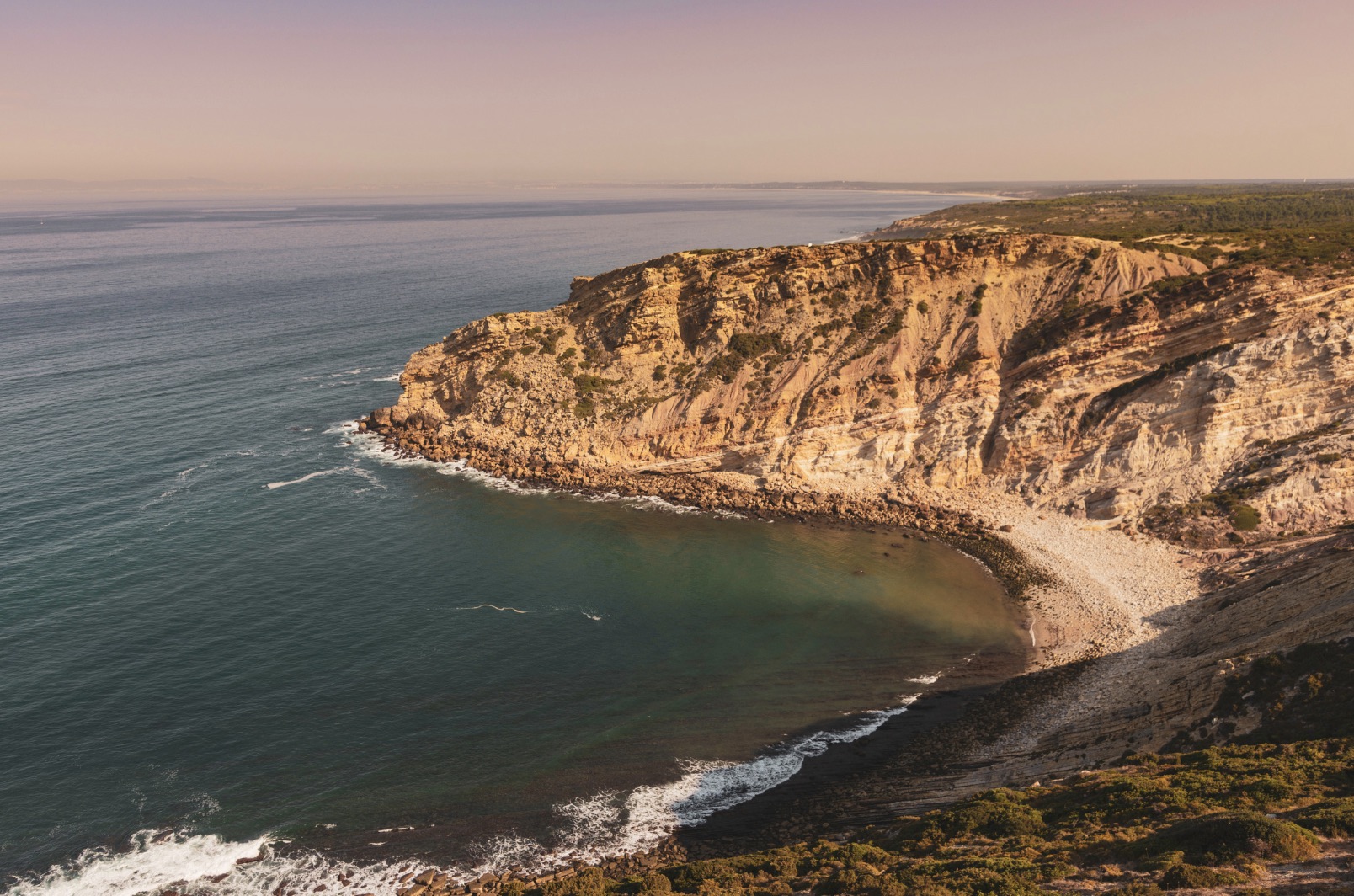
Lagosteiros beach
Technically, there is no one Sesimbra beach, but several beaches within Sesimbra, which is a locality within the district of Setúbal, also a part of the Arrábida Natural Park. As there are so many absolutely great beach options belonging to Sesimbra itself, we have separated them here so that it’d be easier for you to navigate when you head out to explore the area.
To visit the several beaches in the zone, you’d have to first travel from Lisbon to Sesimbra and, from there, make your way to your place of choice. Sesimbra is one of the best day trips from Lisbon, and you can get there by public transportation, either taking a bus or a train.
TST buses depart from Praça da Espanha (blue metro line) or Alcântara to Sesimbra, and the ride takes around one hour. The closest beach once you get to Sesimbra is literally just 5 minutes walk away from the bus stop, and this is the cheapest way to get here.
To get to Sesimbra by train takes a little longer and it’s slightly more expensive, but if you chose to do this, you’d have to take the Fertagus train from the station of Entrecampos to Setúbal. To get from Setúbal to Sesimbra, you’d have to do so by bus (look out for bus 230), or take a taxi ride instead.
Less touristy beaches in Sesimbra

Ribeiro do Cavalo beach
As mentioned above, there are beaches literally by Sesimbra’s town center. White sand beach Praia da California is right by Sesimbra’s bay and, even though it’s really pretty, it certainly gets busy when the weather is inviting, because it’s just so easy to get there!
We like venturing into some of the more alternative beaches near Sesimbra, where we know nature will be less affected by human intervention – after all, these are still beaches within Arrábida Natural Park.
Praia dos Lagosteiros (whose name opens our appetite, as it translates as “lobsterman beach”), for example, feels quite wild to us. So wild that you can even marvel at dinosaur footprint fossils around here! It’s not easy to access this beach near the sanctuary of Cabo Espichel, and that precisely explains why this is such a special place. Can you picture yourself having fun at a beach where sauropods and theropods were running around 150 million years ago?
Praia da Mijona (which sometimes also goes by the names Cova da Mijona or Praia do Ilhau) is even harder to get to than Lagosteiros beach above. The access is a little dangerous, but it is certainly possible to get there on foot. Be cautious and you’ll be rewarded by this wild gem of a beach in Sesimbra. To get to Mijona beach, you need to descend a difficult trail, dug into the ravine, which culminates in this deserted beach. Don’t be surprised to find a house here or go wondering how people who live here bring their groceries down – this is just a house which used to serve as shelter to fishermen who’d get here by boat.
Praia do Ribeiro do Cavalo is yet another beach which needs you to go down a strenuous trail to get there. Always keep in mind that the descent is easier, especially because you can go for a swim when you reach the beach, but climbing up still needs to be done before it gets dark at the end of the day. That being said, this paradise-like beach is all about white powdery sands and the type of blue waters that are calling out your name.
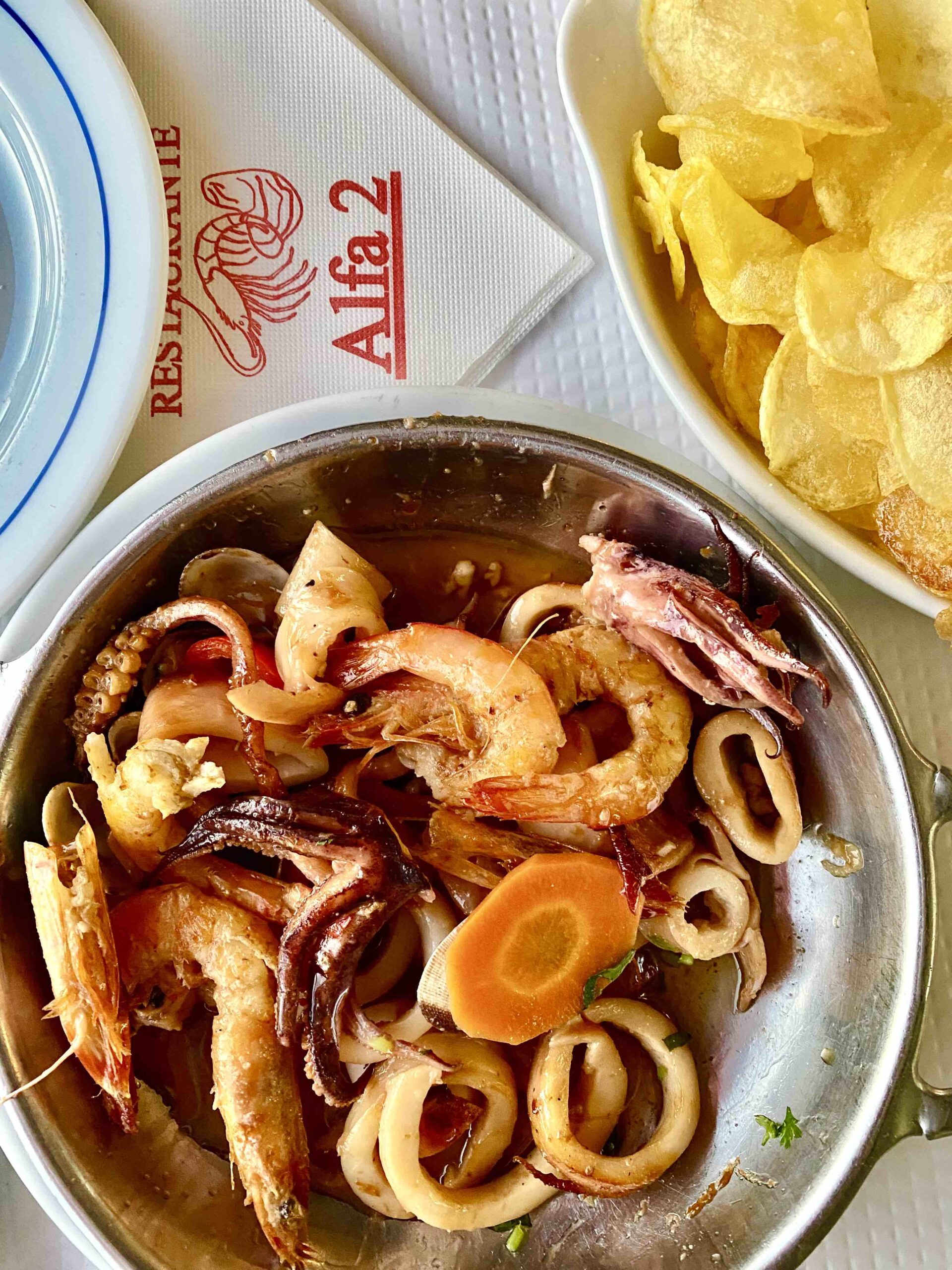
Fried squid and shrimps, with a rich garlic sauce, served with ‘homemade’ fried potatoes and green pea rice at Alfa 2 restaurant.
If you are into surfing or bodyboarding, Praia das Bicas, just south of Praia do Moinho de Baixo, and nearby Campimeco camping grounds, should definitely be on your radar. Besides a long wooden stair going down, there’s barely infrastructure here, but it’s easier to get to than some of the other beaches we explore above.
Keep in mind that you will not find restaurants right by the beaches we mention above, precisely because these are wild beaches. But going to Sesimbra’s town center will grant you the opportunity to choose from a myriad of great restaurants, in this wonderful fish loving place.
Best restaurants near the beach in Sesimbra
Because not every beach restaurant needs to by default include an amazing view as part of the menu, allow us to begin by recommending Alfa 2 (Estrada Nacional 377, 2970-098 Casa do Infantado). There is certainly a reason why this restaurant tends to be packed with locals, and that is that the food is honestly great. Whether you go for fish or meat, because it’s certainly not compulsory to opt for seafood just because you’re by the beach. Alfa 2 certainly delivers! If you ask us, we’d go for the monkfish rice which includes the fish’s liver, and it is such a delicacy!
Sesimbra is known as one of the fish capitals of Portugal, so if you’re in the mood to explore the bounty of the Atlantic ocean cooked Sesimbra style, head to wonderful local restaurants such as Lobo do Mar (Av. dos Náufragos), Filipe (Largo da Marinha 15) or Tasca do Isaías (Rua Cel. Barreto 2). O Rodinhas (Rua Marques de Pombal 25) is a little further away from the beach, but worth getting there to recharge your batteries with impeccable petiscos and wine, after a day at the beach.
To literally eat by the beach in Sesimbra, go to Ribamar (Av. dos Náufragos 29), where you’d be silly to miss out on the cuttlefish roe and razor clam rice with anemone.
Costa da Caparica
How to get to Costa da Caparica from downtown Lisbon
To get to Costa da Caparica when you stay in central Lisbon, you’d have to cross the river to the south bank. You can either do that by a quick 10 minute boat ride, departing from Cais do Sodré to the port of Cacilhas (which belongs to the city of Almada), or using the 25 de Abril bridge which connects Lisbon to Almada.
If you want to keep things simple (unless making a pit stop in Cacilhas tickles your fancy – and we think it should, either on the way there or back), you can make the journey straight from Lisbon to Costa da Caparica, aboard the direct 3710 bus, by local transportation operator Carris Metropolitana. This bus departs from Areeiro and takes you to Costa da Caparica bus station. Even though Caparica is just about 10 kilometers from Lisbon (6 miles), the journey across the river can take just a little shorter than one hour. If you don’t want to use all of that time and you can afford it, taking an Uber or Bolt ride there won’t honestly come to a fortune and it’s so much faster.
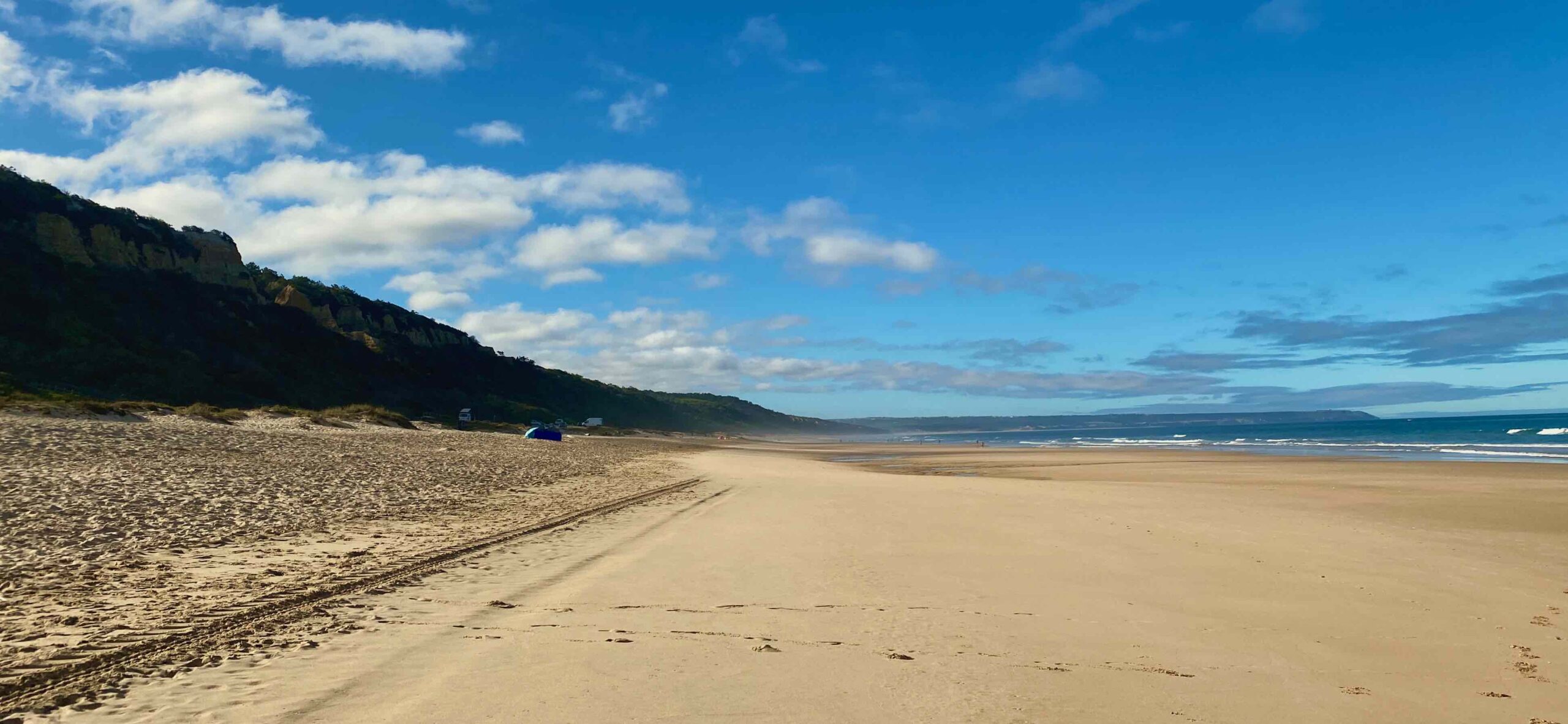
Fonte da Telha beach
If you do decide to check out Cacilhas on your way to Costa da Caparica, use the ferry service which departs every 15 to 20 minutes, and which is operated by the company Transtejo Soflusa – schedules here. From Cacilhas you’d have to take bus 3022 or bus 3011 to Costa da Caparica. If boat rides are your thing, know that a similar trip could be done from Belém’s boat station crossing towards Trafaria, a very picturesque fishing town with wonderful seafood restaurants, and from Trafaria there are bus connectios to Costa da Caparica – once again, as we’re talking about a short distance and not so regular buses, requesting a ride from an app or local taxi could save you a considerable amount of time and hassle.
What is Caparica beach like?
Actually, Costa da Caparica includes more than one beach. We’re talking about 15 kilometers (9 miles) long of sandy areas, and many beaches to choose from.
If you grew up in Lisbon, it is very likely that you have some childhood memories linked with Costa da Caparica, as this is where locals would often go with their families. Because Costa da Caparica is quite long, its beaches are also very diverse. You could choose to spend the day at one of the family oriented beaches closer to the town, go see the fishermen arriving with the fresh catch of the day, or enjoy the LGBT friendly areas in this part of Caparica and south of that.
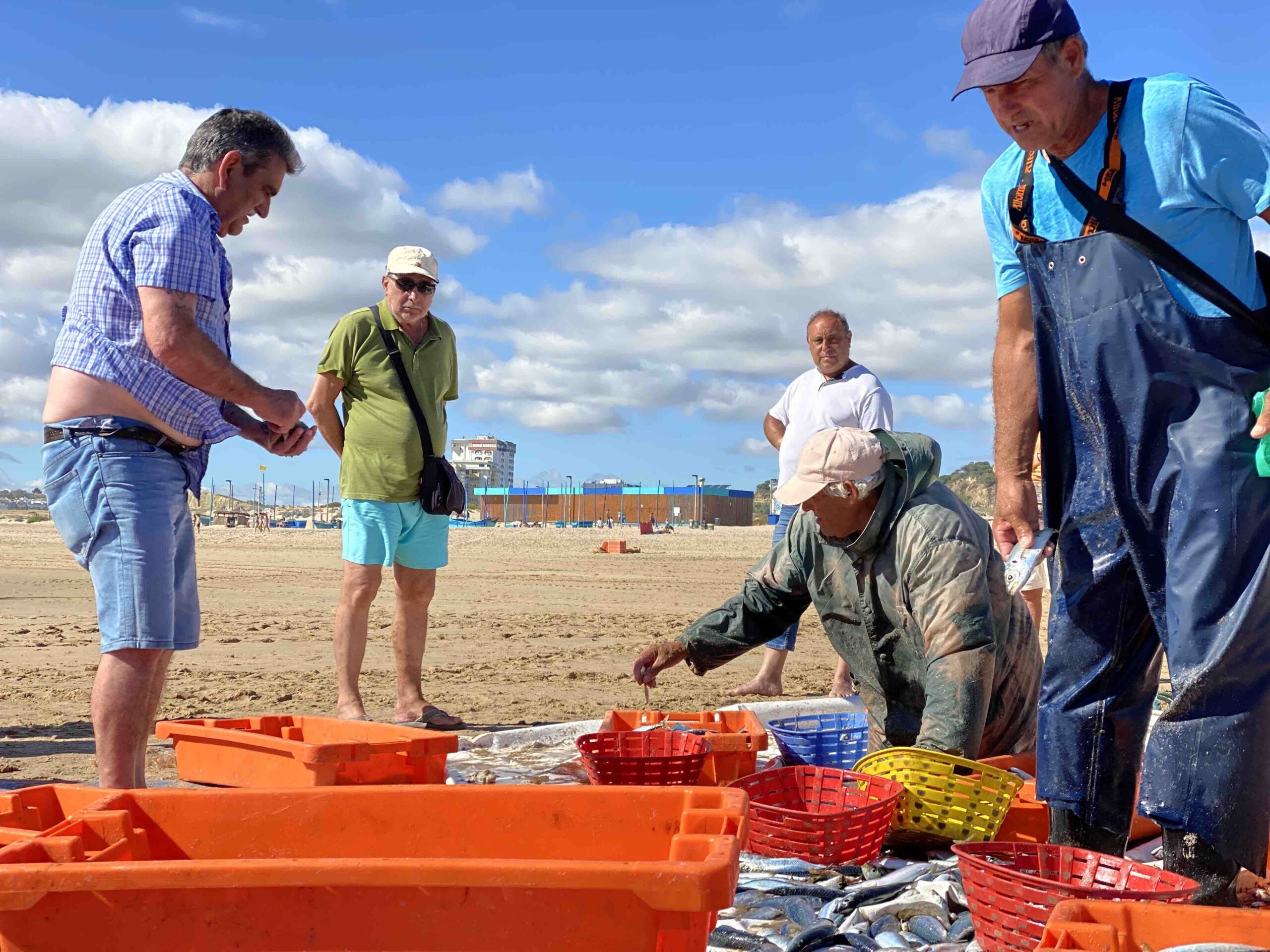
Costa da Caparica fishermen in June, when sardine is queen.
The Protected Landscape of the Fossil Cliffs of Costa da Caparica covers an area with wonderful forest trails and breathtaking viewpoints. You could actually walk all the way to Lagoa de Albufeira, an Atlantic beach connected to a lagoon, surrounded by greenery and peaceful vibes. You could also just drive up to the lagoon and, from here, walk towards the shore eventually reaching the beach.
But if you’re rather just go straight to hang out by the beach, we’d recommend doing so at some of the best unspoiled beaches in Costa da Caparica, besides Fonte da Telha, which tends to be some of our main go-to destinations in the area, for the sake of going to the beach, but also to eat!
Praia da Adiça certainly is one of our favorite wild beaches in Lisbon Portugal and it is a relatively well kept secret in Costa da Caparica. That’s quite probably because, to get there, you ought to descend a long and steep trail. But one thing is for sure, not only down there the scenery is magnificent, there are certainly no crowds that could bother you either.

Arroz de Polvo, an environmental association at Fonte da Telha Beach.
Associação Arroz de Polvo
In 2012, the founders of this association decided, by their own initiative and with the help of a fundraiser, to build a new house for a longtime friend from Fonte da Telha, Luís, who they affectionately called Arroz de Polvo. Luís was a beach lover and fisherman with poor financial conditions, with whom the members of the association developed a relationship of affection, friendship and mutual help.
Currently, Associação Arroz de Polvo, which was established on the 4th of May 2021, is a memorial to Luís’ life and acts as the association’s headquarters. Their intention is to encourage respect for the environment, culture, sports, and creativity through several initiatives, individual and community oriented. For its construction, marine remains and raw materials were privileged, as so to represent their values focused on a more sustainable and integrated society.
Best places to eat in Costa da Caparica
You’ll find all sorts of places to eat in and around Costa da Caparica. From typical Portuguese grills, to over-priced sit-down restaurants, healthy and pseudo-healthy cafes serving foods which will supposedly help you have a “beach body”, to typical beach shacks with straw sun hats and waiters in Hawaiian inspired shirts. So, chances are, no matter what you’re in the mood for, your needs will be well catered to in Costa da Caparica. You can find restaurants in downtown Caparica itself, as well as along the several miles which are officially part of this coast.
Sometimes, when you go to the beach, all you can think of is indulging in a seafood feast. OK, we may be projecting our cravings here but, if you’re like us, you may want to check out Marisqueira Sotavento (Av. 1 de Maio), one of the best seafood restaurants in Costa da Caparica. All the classics from the Portuguese seafood repertoire are well represented here, from shrimp fried in garlic infused olive oil (gambas à guilho), to tangy clams (amêijoas à Bulhão Pato), to a variety of steamed seafood, and even festive disease such as seafood rice or cataplana, a seafood dish cooked inside a clamshell like vessel by the same name.
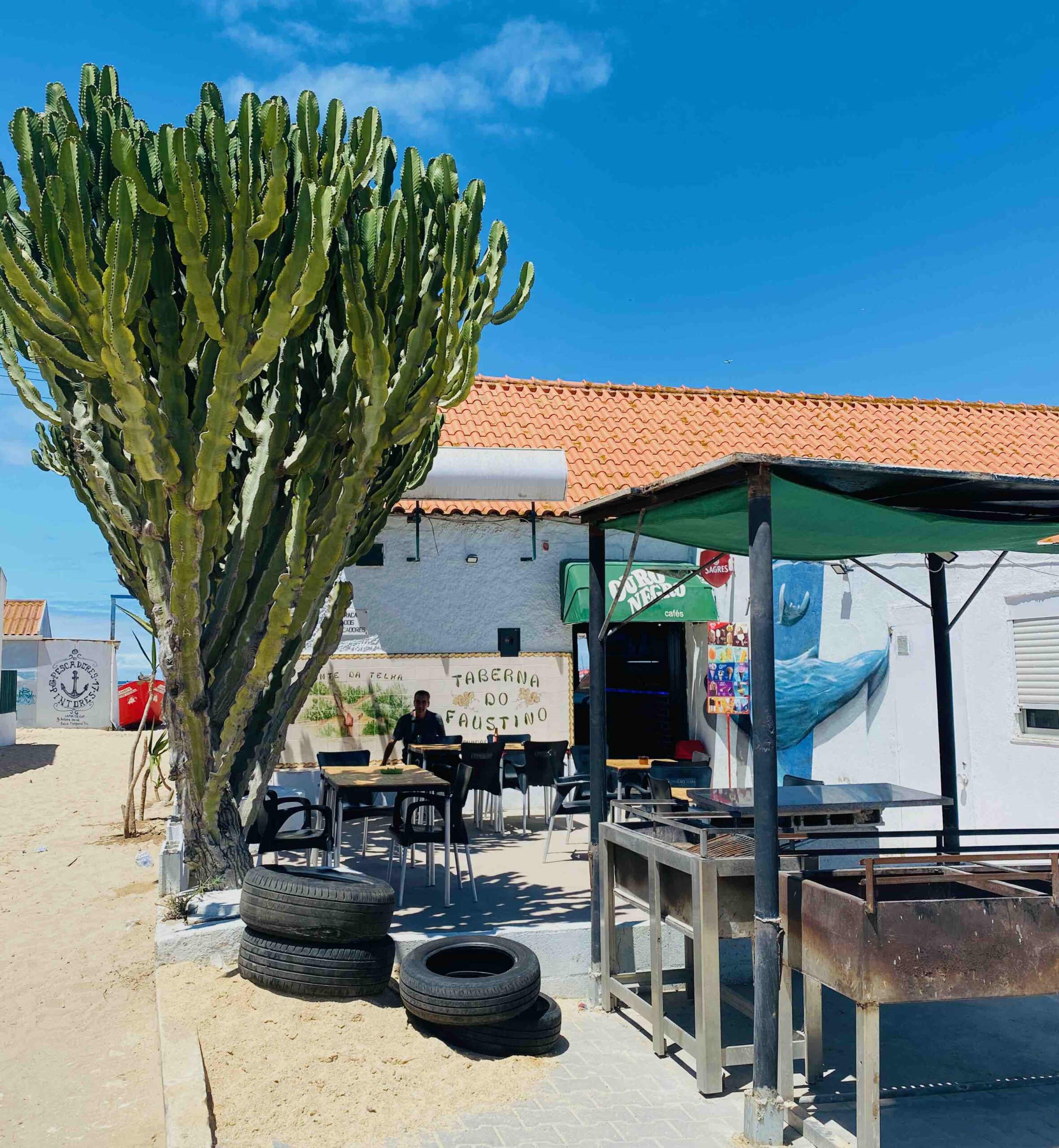
This is one of the unique places miraculously surviving gentrification. Our refuge, at 40 mn from the city.
Cabana do Pescador, at the beach by the same name, is a simple eatery which sure knows how to flawlessly prepare grilled fish. One may think this is an easy thing to achieve but, trust us when we say that, oftentimes, the simplest dishes are the hardest to master. Of course they can count on the primest of ingredients, just out of the Atlantic, as does Apeixonado (Mercado Municipal, Praça da Liberdade Loja 2), a fish restaurant located inside Costa da Caparica’s municipal market.
If you want to treat yourself in a boho chick sort of environment, we recommend visiting the more recent Casa Reîa (Praia da Cabana do Pescador), where Israeli chef Udi Barkan surprises diners with inventive fish, meat and plant based dishes.
Where to drink a cocktail in Costa da Caparica
As there are no Lisbon beach bars per se, as we’re by the river, the closest you can get to having a cocktail by the beach when you’re staying in downtown Lisbon, is probably to head to nearby Costa da Caparica. Thankfully, Caparica does have our basis covered when it comes to drinking with a beach backdrop!
Many of the bars in Costa da Caparica double as cafes and restaurants, serving at least simple meals and some snacks. There’s nothing wrong with that – we love munching on some seafood petiscos after downing a couple of cocktails with the sun going down over the ocean in the background.
To fully embrace the Caparica lifestyle with a drink in hand, allow us to recommend trendy Leblon (Praia das Palmeiras, São João), which promises to teleport you to the beach by the same name in Rio de Janeiro, Brazil – OK, maybe this only happens once you’ve had a drink too many. For an even fancier setting, head to Classico (Av. Afonso de Albuquerque S/N, Trafaria) by celebrity chef Olivier, which promotes itself not as a bar, but as a beach club. Here it’s all about drinks, food but also a certain aspirational lifestyle. All in all, we’d be more likely to end up hanging out at Café do Mar (Muralha da Praia – Apoio 10), where food is good, or Praia Princesa (Est das Praias), which has a little more party vibes, including DJ sets in the evening.
Ericeira
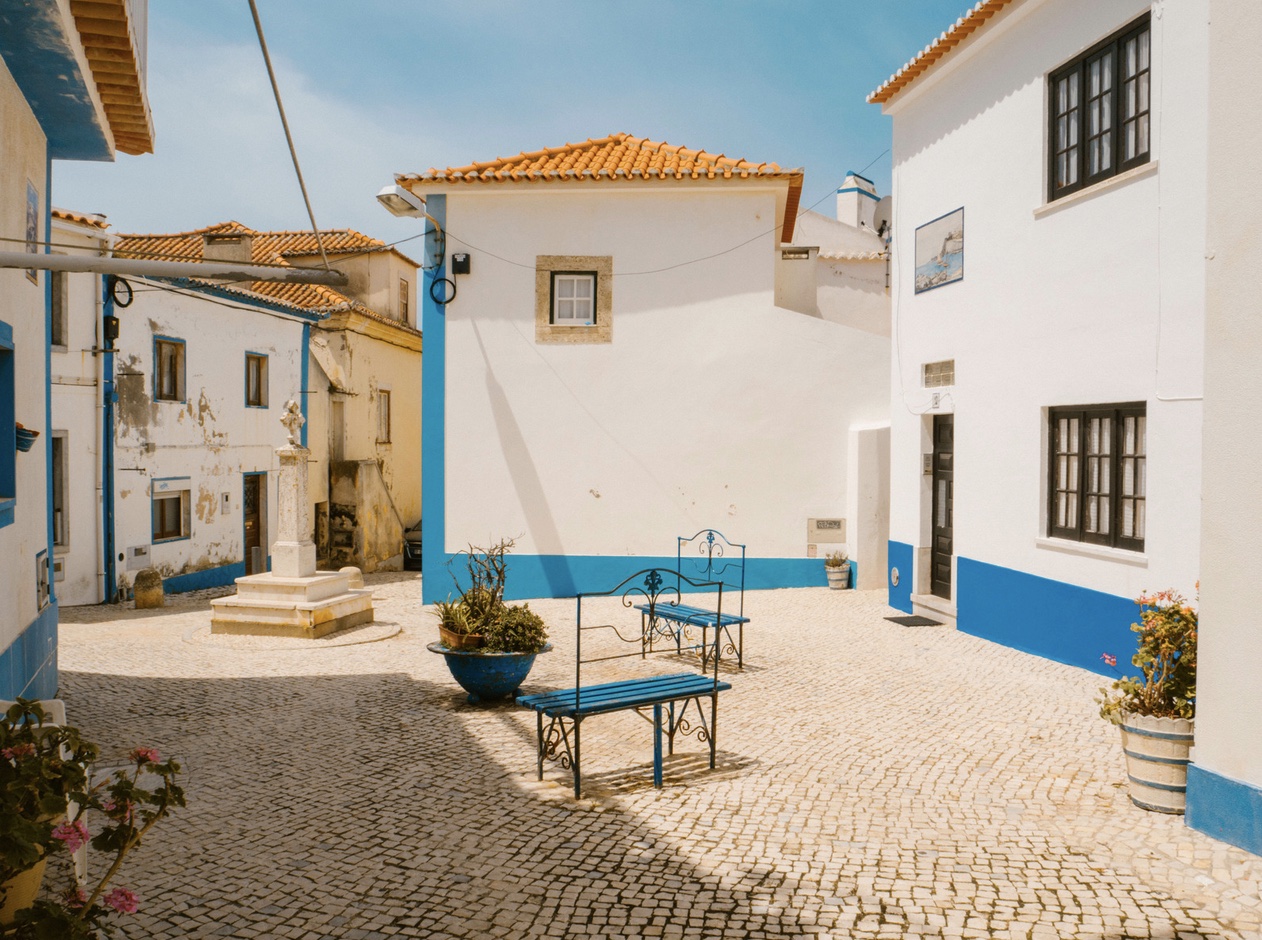
Ericeira village
How to get to Ericeira from Lisbon
Ericeira is one of the favorite day trips from Lisbon, for those city dwellers craving a seafood meal, quite often, after having spent a day at a fairly undisturbed beach. It’s not that Erieira’s beaches aren’t popular, but many of them are so extensive that you can almost always find your own little corner in the sand.
To get from Lisbon to Ericeira, one of the quickest options would be to drive. You can easily get to this fishermen village turned hipster resort town by taking the A8 highway, which is the same path the express bus leaving from Campo Grande (green line on the metro) uses. There are several buses operated by Carris Metropolitana, but be aware that while some are express and go via the highway, others stop often along the way, so the trip can take anywhere between 45 minutes to almost an hour and a half.
If you can rent a car to drive to Ericeira, you can certainly use the highway or take the scenic route, with a little detour via the Cascais-Sintra Natural Park, which would allow you the opportunity to check out several wild beaches and alternative destinations most travelers don’t make it to when visiting Lisbon.
What are the beaches in Ericeira like?
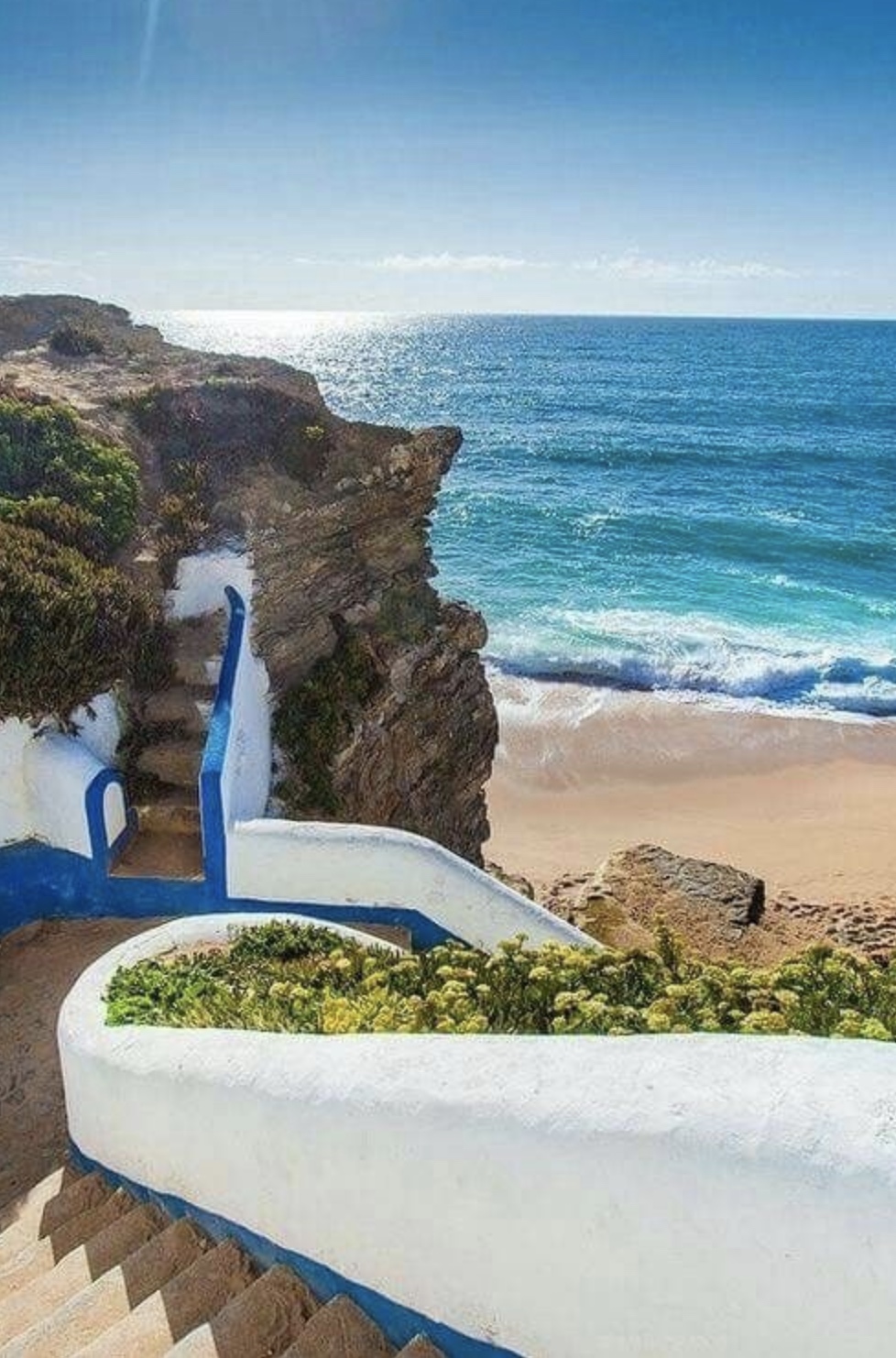
São Sebastião beach
Ericeira is popular amongst surfers as it is literally a World Surfing Reserve. This means that the natural environment and the surging areas, including the waves, are protected. This label also highlights how this watersport is key for the local community, both from a cultural and economical perspective. There are only 10 places in the world which are a part of the World Surfing Reserve, including Ericeira, and several beaches in Australia, the USA, Peru, Chile and Brazil. The locations within Ericeira that belong to the World Surfing Reserve include, amongst others, Pedra Branca, Coxos, São Lourenço and the uber popular Ribeira d’Ilhas.
You may depart from Lisbon during a super sunny day, but chances are you’ll feel a hefty breeze by the time you reach Ericeira. This western part of Portugal is (in)famous for its windy weather and thick sea mist. In fact, back in October of 1910, when the first republic got installed in Portugal, the royal family left for exile departing from Ericeira into the ocean. When we learn history (with a dash of story settling) attending school here in Portugal, we’re often told about the king who disappeared into the heavy mist, on a boat offshore Ericeira.
Even though Ericeira has been slightly gentrified in recent years, in big part because of the surfing culture attracting lots of international visitors and slowmads, it’s still at core a fishermen village. People around here are certainly very connected with the ocean, and that translates into great seafood restaurants but also lovely beaches to spend time at.
Praia dos Pescadores (also known as Praia do Peixe – so, “fishermen beach” or, simply, “fish beach”) is a surf spot in the harbor of Ericeira but don’t let the big swells deter you even if you are a normal beach goer like us. The scenery is rough but beautiful, just be careful when going for a swim, as the ocean is ultra powerful around here, even though this is still considered the best beach for swimming in Ericeira.
Praia de São Sebastião is the best wild beach in Ericeira. It’s crazy that it is so close to Ericeira’s center as, besides the cobbled staircase going down to the sandy area, this beach feels very natural. It is very long but narrow, and the sand can barely be seen when the tide is high. But when the tide allows, São Sebastião is a great spot to lay your towel for some hours of sun bathing in Ericeira.
Best seafood restaurants in Ericeira
As mentioned, Ericeira is currently undergoing a hipster renaissance. As such, there’s no shortage of places serving burgers, avocado toast, breakfast all day and specialty coffee. But we’d like to focus on fish and seafood, which is what us Lisbon locals tend to travel to Ericeira for.
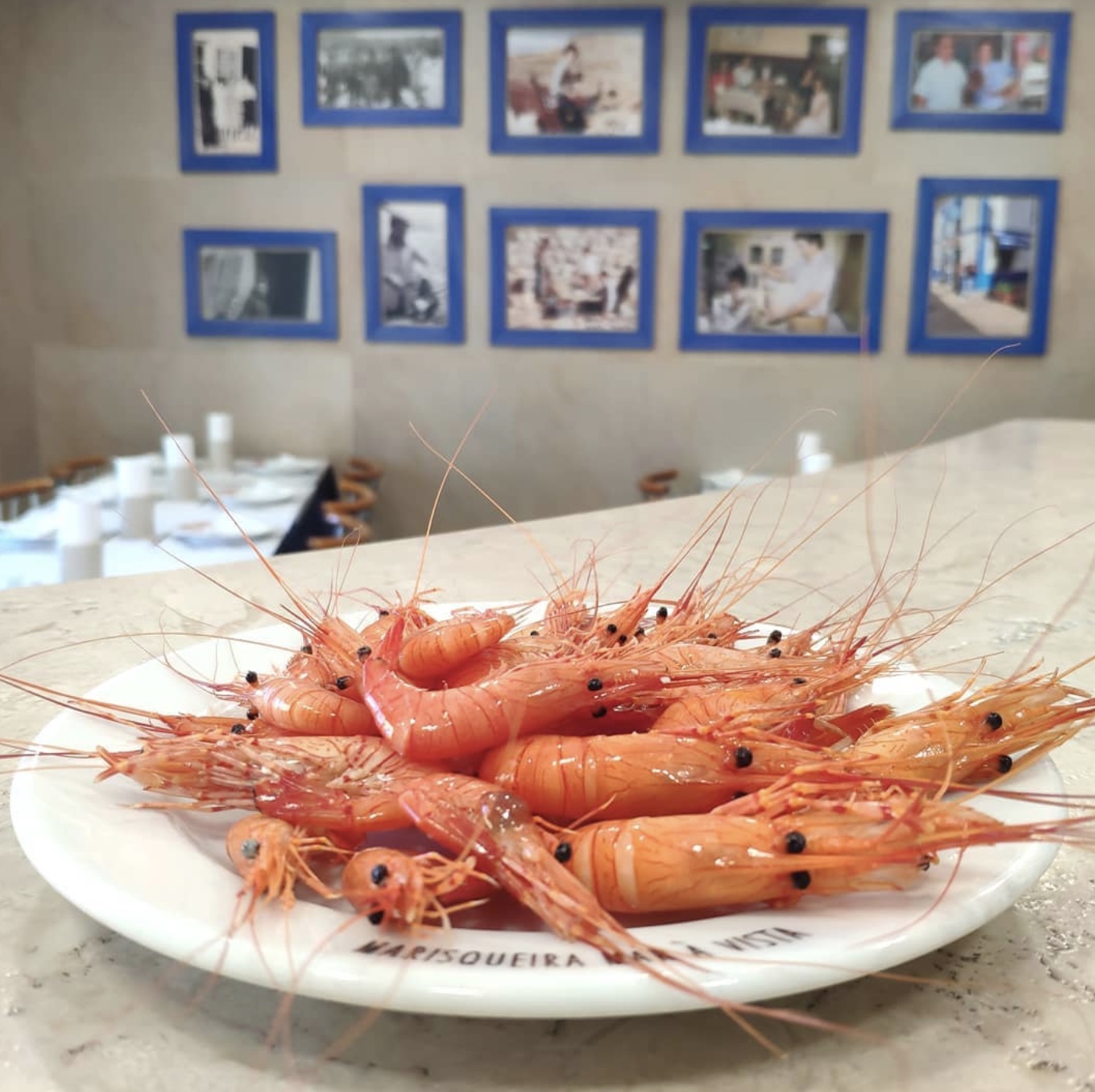
© Mar à Vista restaurant
If you’d really like to get acquainted with the local fish culture, there’s no better start to your journey than to visit Mercado Municipal da Ericeira (Rua do Mercado 22), where there are many fish stands within the several Atlantic varieties on display. This municipal market is only 3 minutes walking from the beach itself, so it can easily be reached even if your main goal is to spend time in nature. Not only to browse the fish vending stalls, but also to attend some of their gastronomic events which happen on special occasions.
To make the most of Ericeira’s dining scene, you must learn the Portuguese word marisqueira, which translates as seafood house. These are the kind of restaurants which, if your budget allows, we’d certainly recommend for you to visit in Ericeira, and even in the nearby town of Ribamar, where excellent marisqueiras line up by the roadside. Some of the most incredible seafood restaurants in Ericeira include Mar à Vista (Rua de Santo António 16), which is a classic, and Onda D’Mar by Furnas (Av. São Sebastião 38), with great views towards the ocean even though it’s not right by the sea.
To eat right by the sea, visit Esplanada Furnas (Rua das Furnas 2), where you get to select your fish by the entrance of the restaurant, even before you take a seat. In Praia de São Lourenço, Golfinho Azul (Rua das Ribas 24) is a great spot to dine as the sun goes down. Even if it gets chilly in the evening, as it often does in Ericeira, you can still admire the awesome views from inside the restaurant, looking out through the large panoramic windows.
There are many seafood specialities which can be enjoyed in Ericeira, including some seasonal treats such as sea urchin, which Ericeira even has an entire gastronomic festival dedicated to. Festival do Ouriço do Mar usually happens around March, so if you’re visiting Lisbon around that time, certainly don’t miss out on this opportunity to sample sea urchin dishes, and participate in fun events and cooking demonstrations.
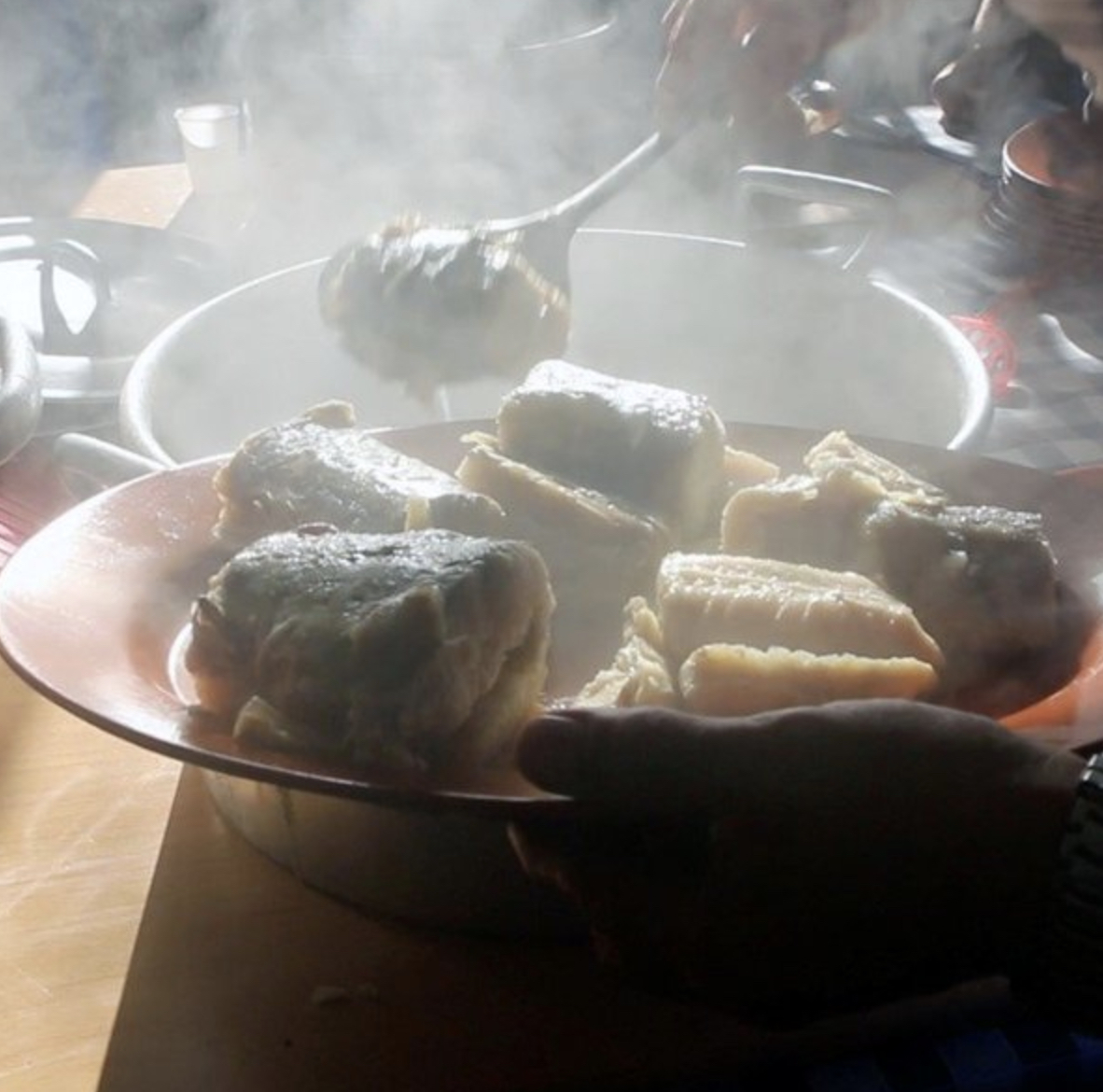
Caneja de Infundice (© Câmara Municipal de Mafra)
Make friends with older men and explore Ericeira’s fermented fish speciality!
Another much more difficult Ericeira speciality that it would actually be very hard for you to try is caneja de infundice, something that the vast majority of Portuguese have not tried or even heard about. Ask older folks in Ericeira though and, if they hang out with the “cool caneja crowd” they’d proudly proclaim how they are a part of the Confraria da Caneja d’Infundice, a fraternity meant to keep the stinky tradition alive. We say stinky as caneja is a fermented (some would say rotten) fish speciality, the type of dish even chef Andrew Zimmern from Bizarre Foods would likely have a little trouble tasting without gagging. If caneja refers to the species of fish, a type of small relative of the shark, the odd word infundice actually comes in the Portuguese dictionary with the explanation “a kind of bleach made from urine, in which very dirty clothes are soaked, so that they can be washed more easily later.’ – sounds really appetizing, doesn’t it? Back in the days prior to refrigeration, fishermen would wrap this fish in gaze and bury it underground for around 15 days. After that time, the fish ferments and displays a distinct aroma of ammonia. The fish is afterwards cut into pieces, boiled and served alongside also boiled potatoes. The key to enjoying your caneja de infundice is to drench the food in a good olive oil to smooth things out but, even though older generations of Ericeira natives swear by this delicacy, no local restaurant would dare to serve this dish, as its strong odor would certainly detract lots of paying customers. If you want to ever be able to try caneja de infundice, go hang out in small cafes and inconspicuous taverns around Ericeira. Make friends with older men and don’t be afraid to ask. You may get lucky as some of us have been in the past!
Sintra
How to get to Sintra’s beaches from Lisbon
Getting to Sintra from downtown Lisbon is as easy as hopping on the CP operated train from Rossio to Sintra. Many travelers basing themselves in Lisbon do this for a day trip filled with history, castles, fairytale-like forest landscapes and lots of romantic vibes. But what about if you want to hit the beaches near Sintra?
Once again, having your own car can be useful, particularly if you’re planning to go to more than one beach, but you could certainly get to Sintra by train and, from there, hop on the local buses which connect to the coastal areas. The line you take would depend on which beach you are planning to spend time at. Either way, keep in mind that Sintra’s beaches are relatively close to Lisbon but you’d still need to at least travel for about an hour to get there. As such, if you’re just planning to spend a couple of hours by the ocean, you’d be better off hitting either Costa da Caparica, or one of the beaches around Estoril or Cascais.
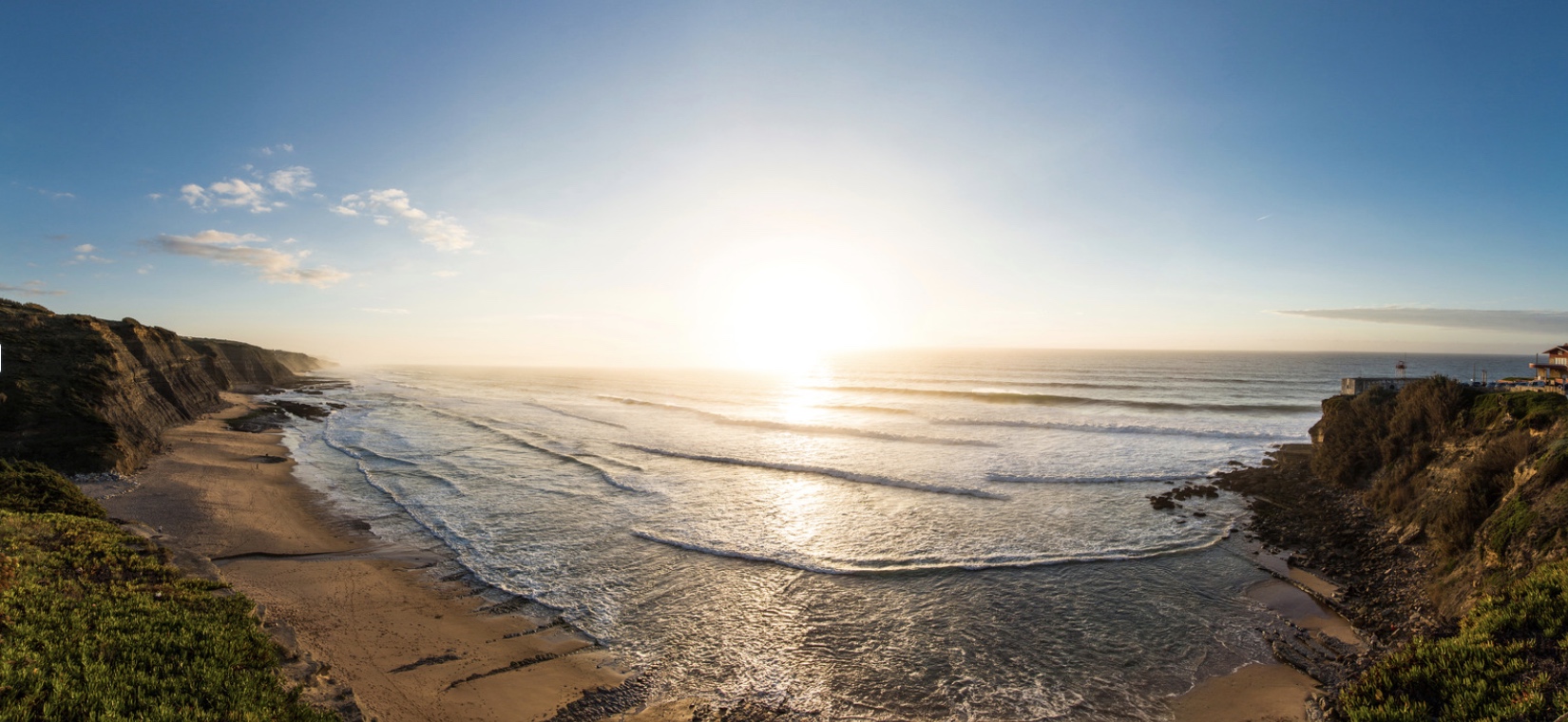
Magoito beach
The best wild beaches in Sintra
Logistics aside, there’s no doubt that there are some truly spectacular beaches around Sintra. These are located within the Cascais-Sintra Natural Park so, just like it happens with Arrábida above, they are as natural as can be within such close proximity to civilization.
Praia do Magoito is a relatively known beach in Sintra, but not everyone would be willing to walk the 20 minutes or so which would connect you to Praia do Giribeto, sometimes also known as Praia de Gerebete. This wild beach in São João das Lampas doesn’t have an extensive sandy area and it sits at the bottom of an imposing ravine. The scenery is dramatic and the powerful ocean will leave you in awe of nature. To get to Giribeto beach you must walk via a dirt path through the villages of Assafora and Magoito that culminates in a trail of high difficulty, on top of the cliff, towards the beach. Folks with access to a boat can also get to the beach by the sea. In fact, most of the people you’ll see coming here are actually fishermen.
Praia do Cavalo is another tiny beach in Sintra, which you can access on foot from Praia da Adraga, but only when the tide is low – make sure you learn about the tides before embarking on this adventurous journey, as you must return to your initial point before the ocean pulls a prank on you and you get stranded in Cavalos beach!
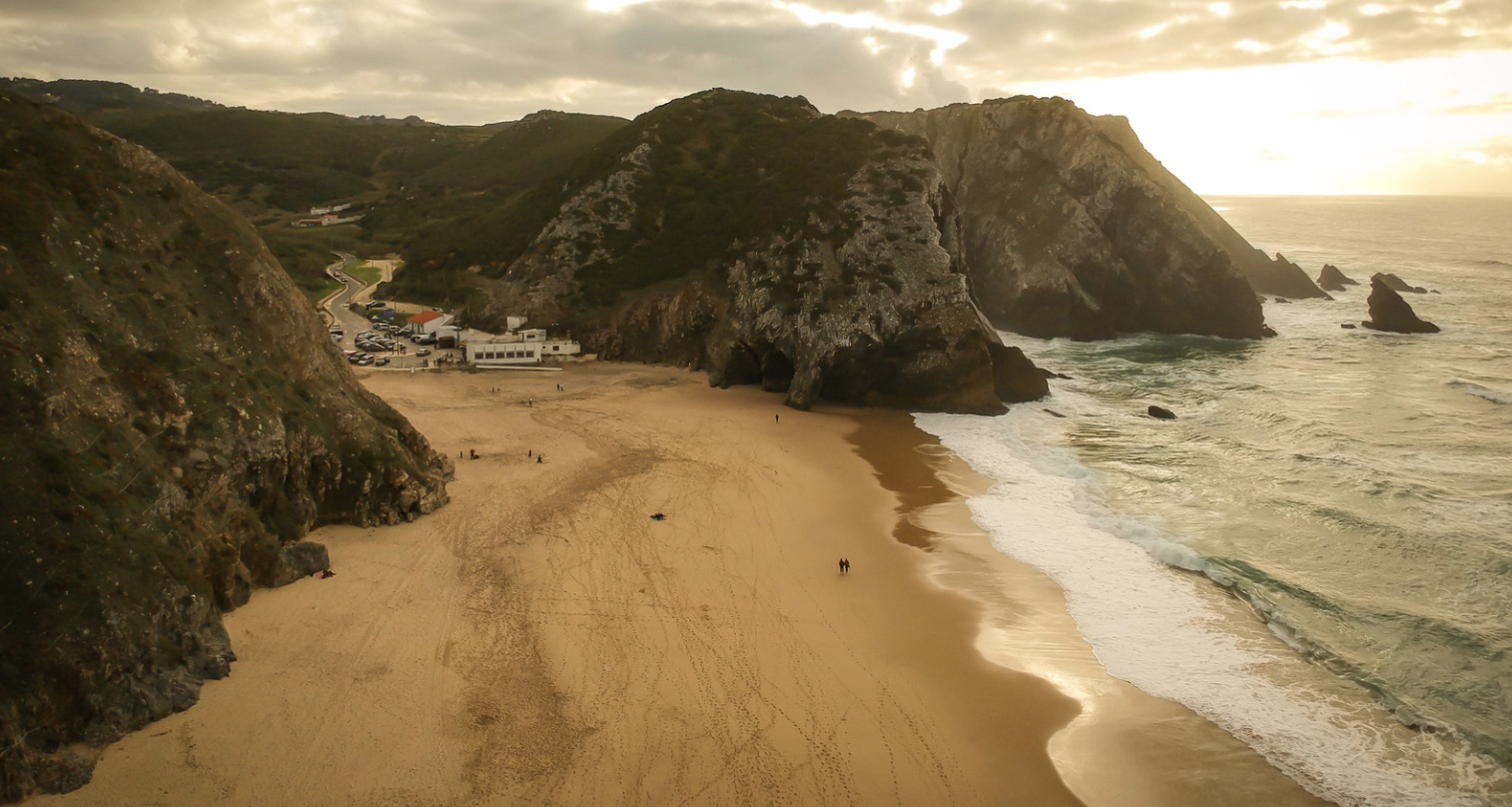
Adraga beach with Adraga restaurant facing the sea (see presentation below)
Praia da Adraga, on the other hand, is relatively popular, not only because of the natural beauty of the beach itself, but because it’s home to wonderful eateries where you’ll see city folks and local fishermen mingle, as they chomp down full plates of fish and other sea delicacies (more on that below).
Praia da Aguda is a wild beach with no facilities, where the crowd is mostly made up of fishermen, nudists and folks with their dogs, who find a safe haven in one of the very few beaches which allow pets around Lisbon.
If you fancy visiting the biggest beach in Sintra, head to Praia da Vigia, in the south of São Julião, Assafora. This is such a sizable beach that it almost feels like several beaches within one, as there are different areas with different atmospheres, including a naturist area in the southernmost part of Vigia beach.
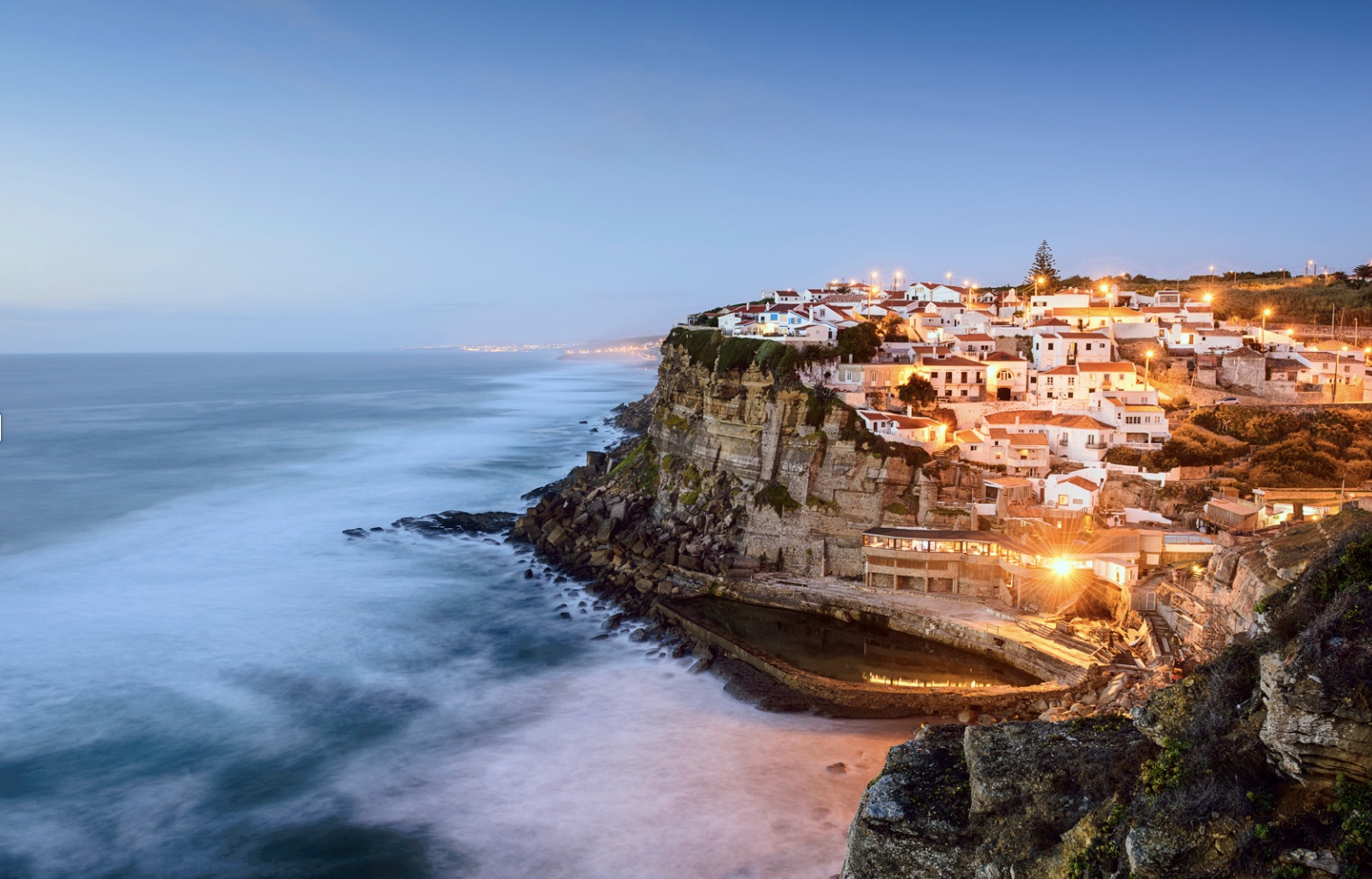
Azenhas do Mar, view from the belvedere
Praia Pequena (literally “small beach”) can be reached on foot via a 10 minute walk from Praia Grande, which translates as “big beach” but has nothing going on Vigia above. We like Pequena beach because it’s secluded and fairly sheltered from the northern winds that sometimes prevent a day out on the beach in Sintra from being as pleasant as one would ideally like it to be.
Where to eat by the beach near Sintra
One of the most acclaimed beach restaurants in Sintra is Azenhas do Mar (Lugar das Azenhas, Colares), in a town by the same name. This small and picturesque town doesn’t have direct sea access or, better yet, getting into the ocean here, would simply be reckless. Instead, Azenhas do Mar complex includes a seawater pool and a wonderful restaurant, where the views and the quality of the food go hand in hand.
When we visit Praia Grande and Praia Pequena, we like going to O Crôa (Av. Alfredo Coelho 11, Colares), where it is all about feasting on fish with a view. This is the kind of traditional fish restaurant Portuguese families still travel for. The kind of place where you know your fish will be grilled just right, charred enough on the outside, but with the flesh remaining succulent on the inside. Of course you can opt for more elaborate dishes, and we hear their shrimp rice (arroz de camarão) is to die for. Whatever you order, ask for a nice bottle of wine and sip it slowly as you enjoy the surroundings – honestly, life doesn’t get much better than this.
Restaurante da Adraga (Rua da Praia da Adraga, Colares) is one of our favorite beach restaurants in Sintra. This is a fairly pricey fish restaurant (something quite standard for beach front restaurants in the area) but that curiously includes a less formal area where they sell fish soup (sopa de peixe) and savory fried snacks such as wonderful samosas (chamuças). We like it there, as you can have a drink and a down to earth delicious meal, side by side with fishermen hanging out or even working on repairing their nets in between sips.
Esplanada de São Julião, right by the entrance of the beach by the same name, has an inviting terrace where you’d be insane not to grab a seat and order a drink. This no frills cafe and restaurant focusing on simple meals is proof that not everything has to be touristic or pricey, even in a much in demand area.
Best gay beaches near Lisbon
In theory, all beaches in Lisbon are gay and LGBTQI+ friendly. But that doesn’t mean that there aren’t some particular beach areas which are extra welcoming to the LGBTQI+ community or that you may want to visit if you want to eventually meet people and mingle.
An important thing to keep in mind is that, even if some of these gay beaches near Lisbon are particularly appealing to the queer community, they’re certainly still open and enjoyable for everybody else to come hang out.
One thing many of them do have in common is that they aren’t easy to access. We’re talking about fairly “secret” beaches nestled in natural setups which will reward those who take the time to get there!
How to get to beach 19 from Lisbon?
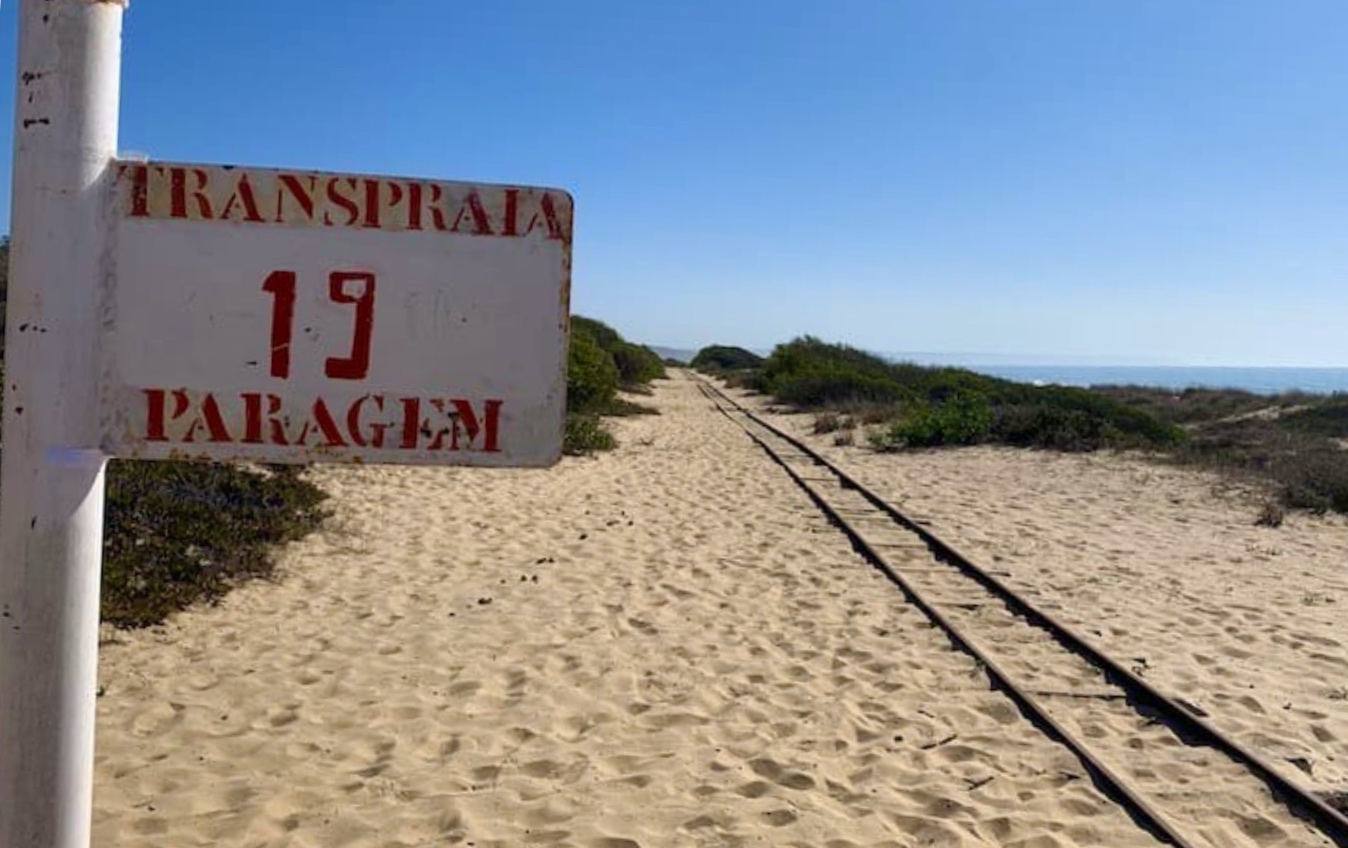
The last stop of the beach train, now inactive since 2020, gave the name to the beac
Praia 19, or beach 19, is one of the most sought-after gay beaches near Lisbon and often highlighted as one of the very best beaches in Europe. Praia 19’s vibes are all about inclusivity and freedom, and a certain sense of liberation which can be enjoyed along the coastline with continuous cliffs, and the many sand dunes which guarantee a little privacy to those who want it.
Beach 19 in Costa da Caparica is not only a beach dedicated to the LGBTQI+ community, it is also a nudist beach. Of course both these things don’t necessarily need to go hand in hand but, in the case of Praia 19, they do.
To get to beach 19 from Lisbon, your best bet is to get to Costa da Caparica (see our tips above) and, from the town center, hail a taxi or ask for a ride on Uber or Bolt. This is a secluded beach which is not particularly easy to get to. It is precisely this isolation that very organically ended up turning beach 19 into a naturist beach.
Until 2020, there was a train which could come all the way here. This particular beach was right in front of stop number 19 of the Fonte da Telha train line and it was precisely because of this now extinct train, that the beach got its name from. Stop 19 was literally the last stop on the train line, connecting to a beach not many would care to visit and that, over time, became a true favorite of the LGBTQ2S+ community.
There are no support facilities anywhere near. If you need to use the restroom there’s of course nature all around for it. But to hit a restaurant or a bar, you’d have to walk 15 to 20 minutes, either in the direction of Praia da Bela Vista, or towards Fonte da Telha. You may not have fancy beach bars in Praia 19, but the atmosphere is quite worldly and, dare we even say cosmopolitan, as beach 19 attracts folks from all walks of life and ages, and the international community is very well represented here too.
Alongside Praia da NATO (see more info below), Praia 19 is the best beach destination in Costa da Caparica for the LGBTQI+ community.
Praia da NATO gay beach
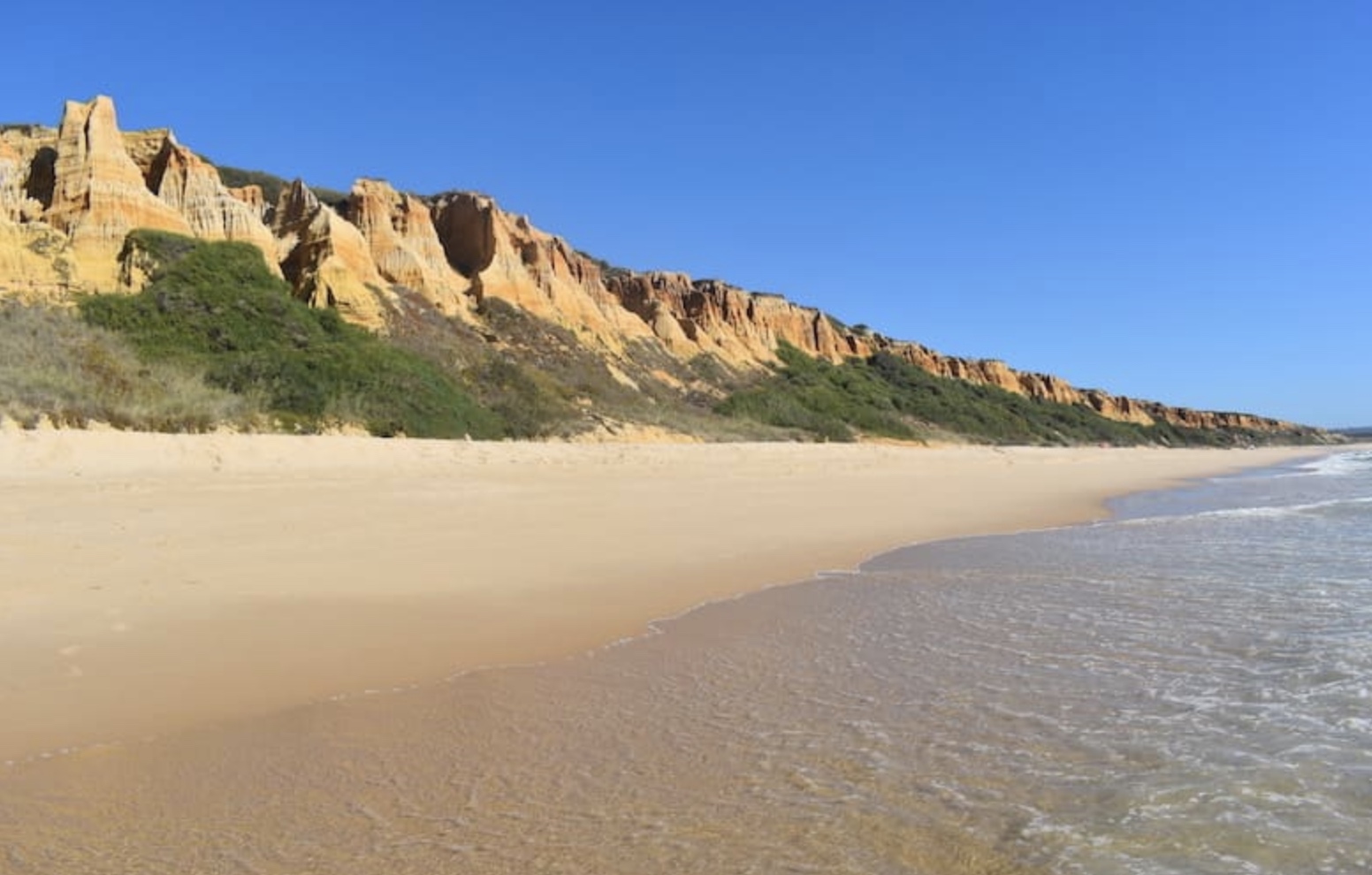
NATO beach or Adiça beach
Praia da NATO, also known as Praia da Adiça (like we refer to it above), is another great gay beach in Costa da Caparica. The name is explained by the fact that it is located near the base of this intergovernmental organization. It is technically located in Fonte da Telha, a small fishing town belonging to Caparica, where we love to go hang out to mingle with fishermen and, sometimes, simply marvel and be appreciative of their hard work, as boats full of fresh fish reach the shore.
To get to Praia da NATO, you’d have to travel from Lisbon to Costa da Caparica. Costa da Caparica is connected to Fonte da Telha by bus, but it would only make sense for you to wait by the bus stop if you’re willing to actually walk from Fonte da Telha to NATO beach. Otherwise, a cab ride is a simpler and quicker option.
Just like beach 19, NATO beach is also officially a nudist beach. Even though it is an area preferred by the LGBTQI+ community, many beach goers do end up coming here when nearby Fonte da Telha gets a little busy and they crave a more tranquil spot.
Just like Praia 19 above, there are no facilities or restaurants nearby. Once again, your best beat for a bite would be to head to Fonte da Telha, where there are plenty of good opinions for you to choose from.
Praia do Meco, Portugal’s first ever nudist beach
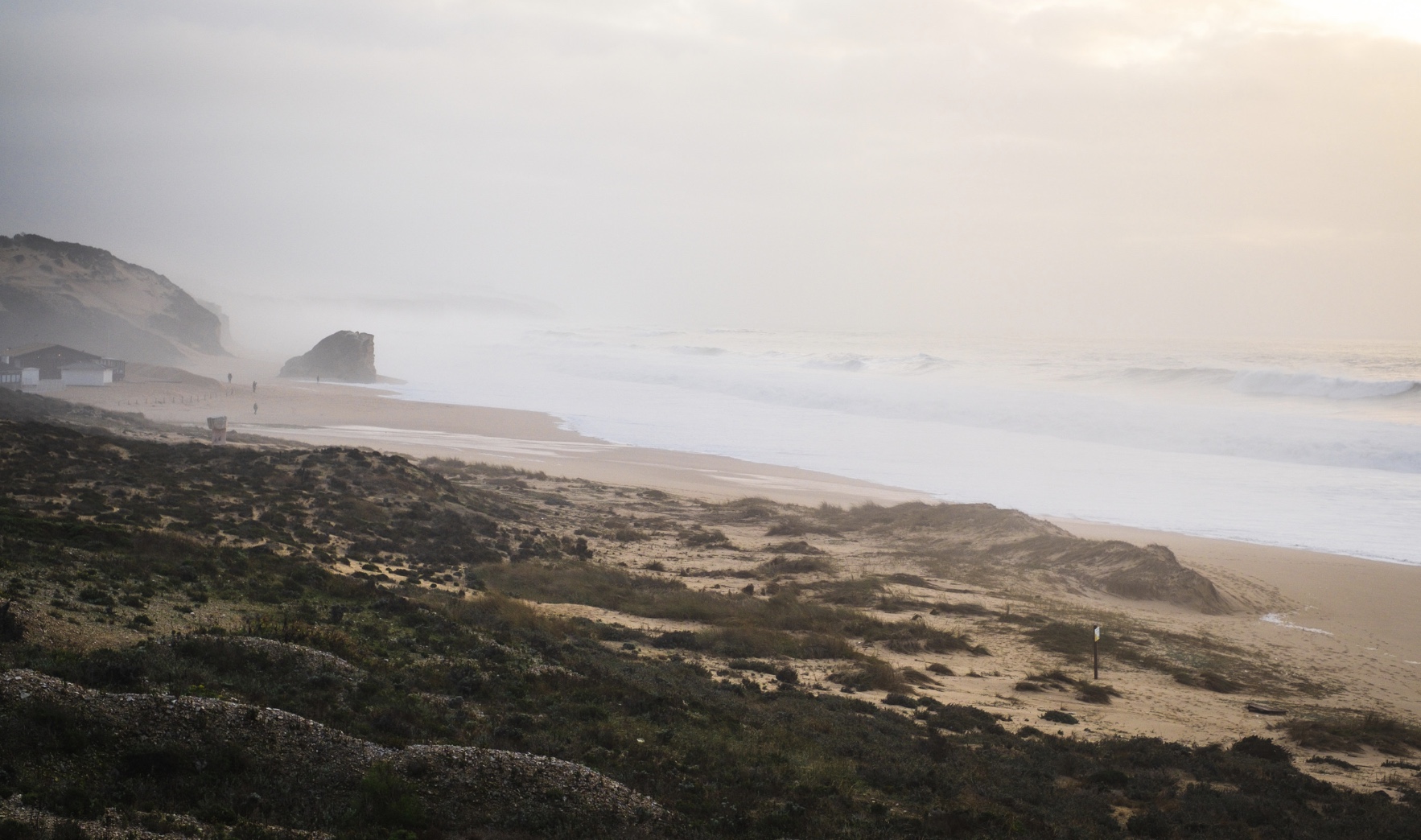
Meco beach in February, also a beautiful scenery for a walk
Meco is a mecca for hardcore beach lovers who appreciate having space. As you’d need a car (or a ride) to get to this beach in Sesimbra, you can certainly expect to have plenty of room for yourself around here, in heavy contrast with other more touristic beaches closer to Lisbon.
Meco was the first ever designated nudist beach in Portugal and, even though this title was only officially granted in 1995, it had naturally (pun intended) been this way since the 80s.
As the sea is rough, it may not be the best beach for swimming, but it’s certainly great for sun bathing and even for eating out. Bar do Peixe (Praia das Bicas, Hangar do Peixe) is a restaurant and bar which, unlike other beach restaurants, is actually open all year long. If you are looking for a gay beach, which is also nudist and actually a pretty good food destination, look no further than Meco.
Meco’s distinct bohemian vibes are just about a 50 minute drive from Lisbon, via the 25 de Abril bridge and the A2 highway, until you need to get out via exit 2 towards N10/N378, in the direction of Sesimbra/Azeitão.
Praia da Ursa, the western most beach in Europe
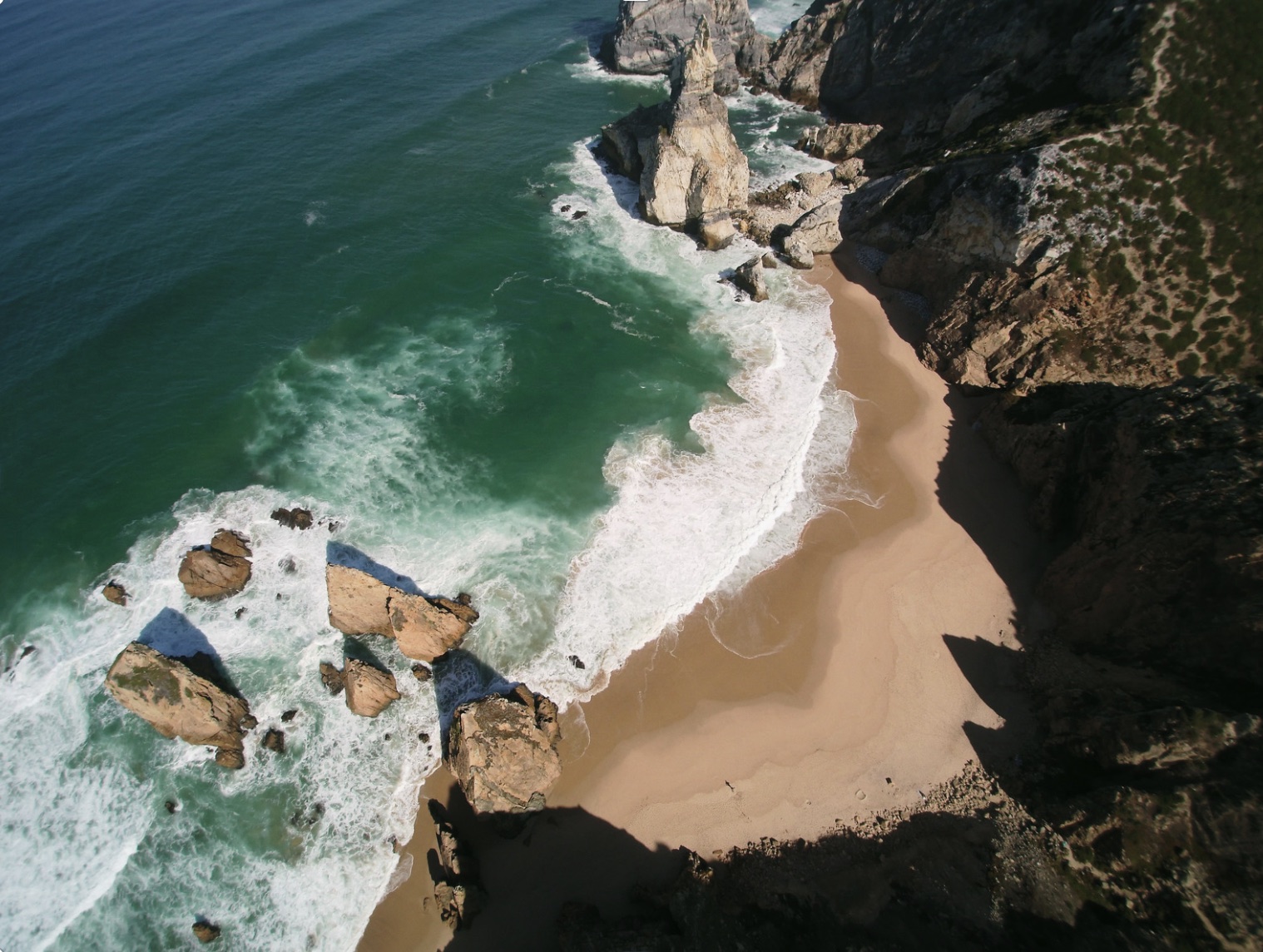
Ursa beach view from the top
Praia da Ursa has often been highlighted as one of the most beautiful beaches in Portugal, and in the world! Once again, we have Nature to thank for this spectacular place, but also the fact that this beach is not within easy reach, as this keeps things as unspoiled as can be, in spite of Ursa’s proximity to Cabo da Roca, the heavily touristic (yet undouble visually striking) westernmost part of Europe.
To access Praia da Ursa you need to go down a steep path, which of course you need to retrace to get back to your car – so make sure you pack light! If you don’t have a car there are buses which connect Sintra to Cabo da Roca (look for bus lines 403 and 417) and, from here, you can walk for about 1 kilometer (a little over half a mile) to the start of the trail.
Gay beach in Ericeira
We have briefly mentioned Praia da Vigia above, but did not come around to share that this is also a preferred beach of the LGBTQI+ community, particularly towards the southernmost part of the beach.
Vigia beach, near Assafora and Ericeira, is honestly one of the best well kept beach secrets near Lisbon. To get there you’d need to drive to the much more popular São Julião Beach in Ericeira and after you cross this beach, turn right onto a dirt road. There is a car park and, from here, you need to walk along the cliff towards the part where you’ll have to go down a dirt path. Once at Vigia beach, if you care about being in the “gay area”, we’d recommend getting a spot towards the south of the beach.
As Vigia is a very concealed beach, there are no facilities whatsoever nearby. But you bet nature is stunning and the experience can be very rewarding if you’re willing to rough it out a little!
Nudists beaches near Lisbon
We have already mentioned 3 nudist beaches in Lisbon, which also happen to be gay beaches. But besides Praia 19, Praia da NATO and Meco, there are other spots naturists traveling to Lisbon may want to check out. Some of them are officially nudist and while removing your clothes isn’t mandatory, there’s a certain protocol of naturist beaches which should be respected. Besides the designated nudist beaches, there are other unofficial beach areas where beach goers are known to walk around as freely as they wish to.
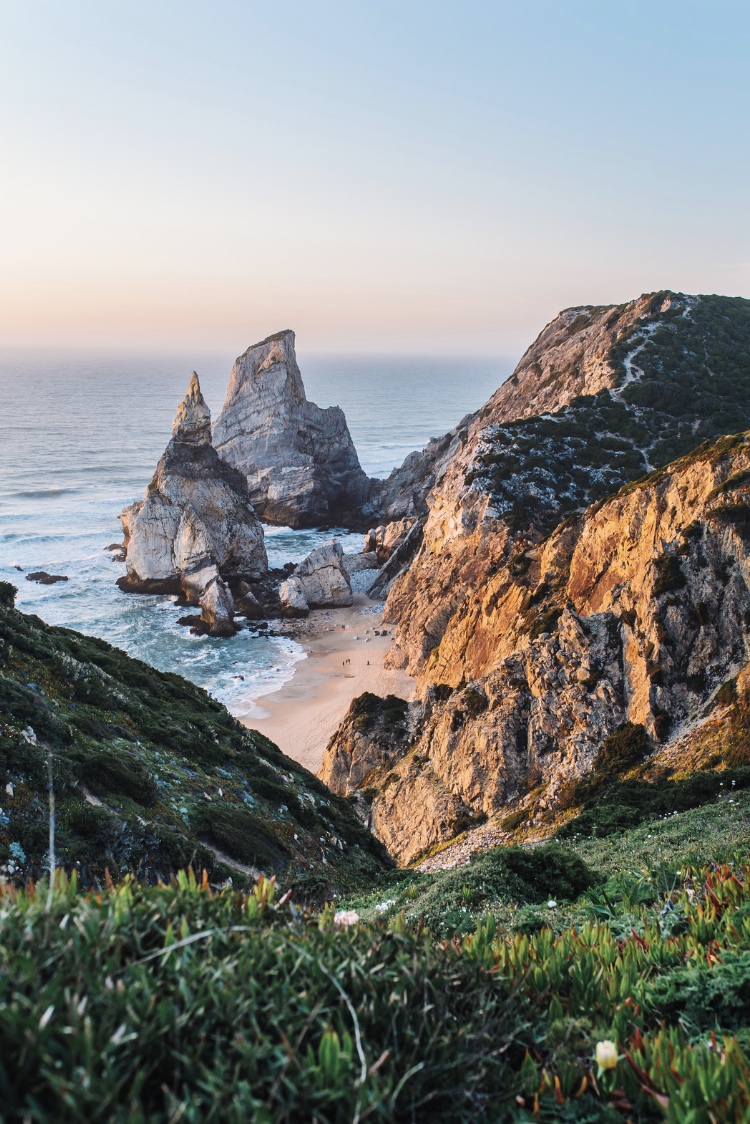
Ursa beach with the three stone bears on the horizon which give name to the beach
Nude beaches along the Lisbon coast include the official Praia da Bela Vista, right above Praia 19, in Costa da Caparica. You can get there walking for about half an hour from Fonte da Telha or, of course, driving.
Rio de Prata, right to the south of Meco, is another officially designated nudist beach in Costa da Caparica. Don’t be surprised if you come here and you see sunbathers slathered with mud from the nearby river, as the mud is believed to act as a natural sunblock and even moisturize your skin as it protects it from the sun. You can wash it all off with a refreshing dip in the ocean before you get back home and this remote place is honestly the kind of ideal setup to go a little wild, wouldn’t you say?
Praia da Ursa, which we also highlight above as a gay destination, is also a partially nudist beach. It’s not officially naturist but the Portuguese Naturist Federation highlights it as a beach where “nudity is tolerated”.
Also in Sintra, Aguda is a wild nude beach, which is located between the much more popular Azenhas do Mar and Magoito areas. There are locals and fishermen hanging out by this beach as well, which is not officially nude, but everyone sees naturism as… well… natural! So you will most certainly feel comfortable at Praia da Aguda if you decide to remove all of your clothes.
For other naturist beaches near Lisbon, or anywhere else in Portugal, we recommend referring to the Portuguese Naturist Federation.
Now that you know about some of the best beaches in Lisbon, we are curious to know where you’d like to spend time when you come to visit Portugal? Take a photo of your favorite beach near Lisbon and tag us: ohmycodtours!
Article by :
Zara Quiroga (freelance food writer and food & cultural leader at Oh! My Cod Pico Trips)
Sílvia Olivença (anthropologist and food guide/CEO at Oh! My Cod Ethnographic Food Tours & Trips)
Photos by:
Sílvia Olivença (anthropologist and food guide/CEO at Oh! My Cod Ethnographic Food Tours & Trips)
Want to more about Portuguese cuisine and its influences?
Fish (r)Evolution: from the Roman times to contemporary Portuguese Chefs
A day trip to Setúbal from Lisbon filled with history, sea culture and incredible cuisine
How Portugal influenced Indian cuisine
Alentejo and Algarve: culinary traditions of the South of Portugal
